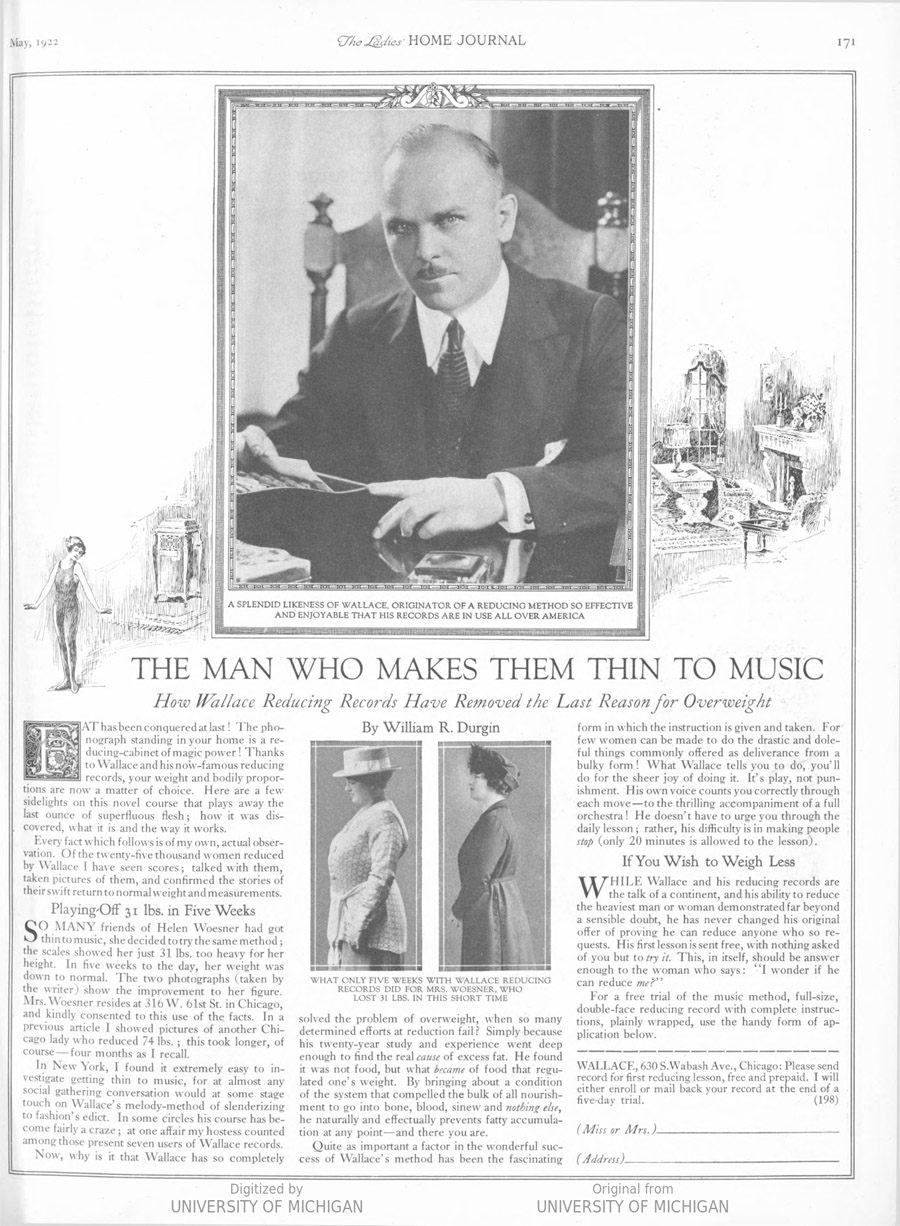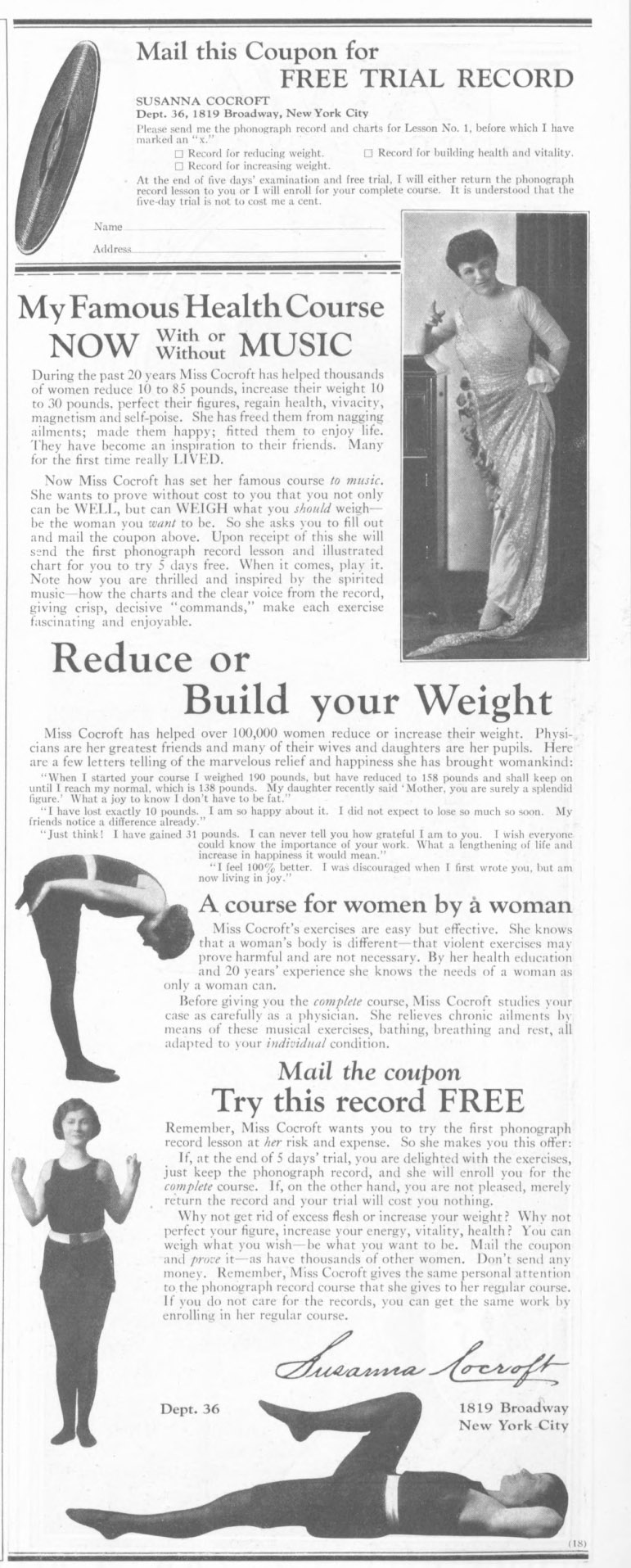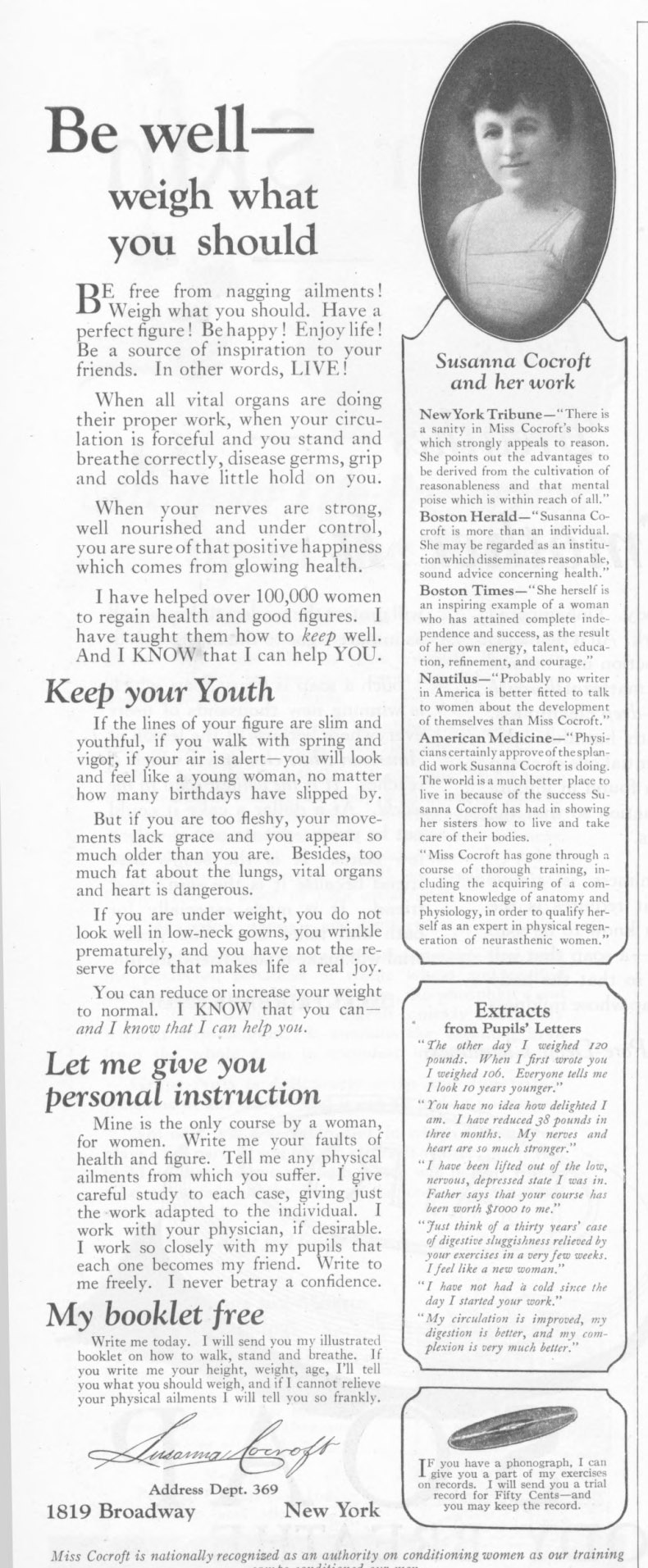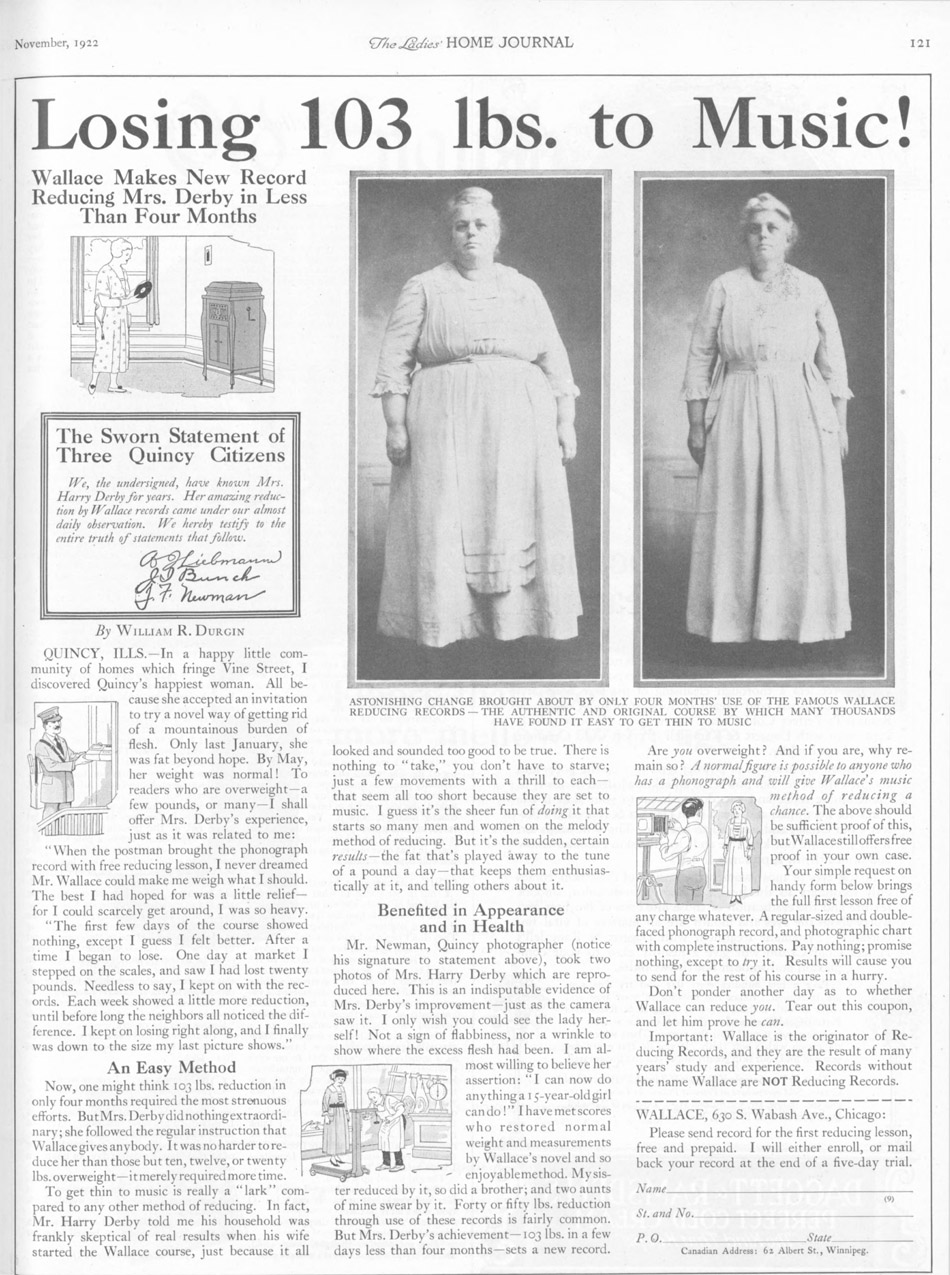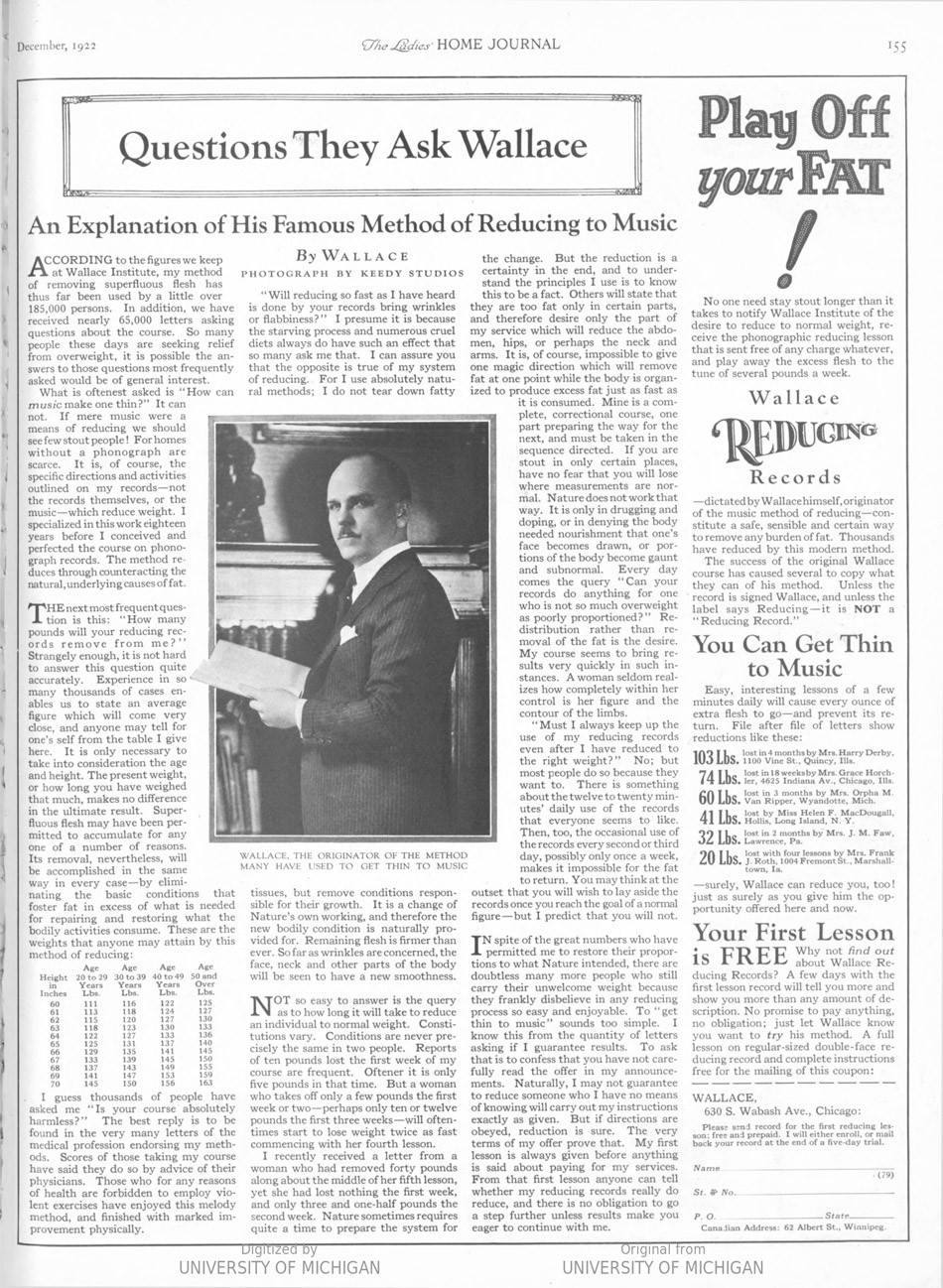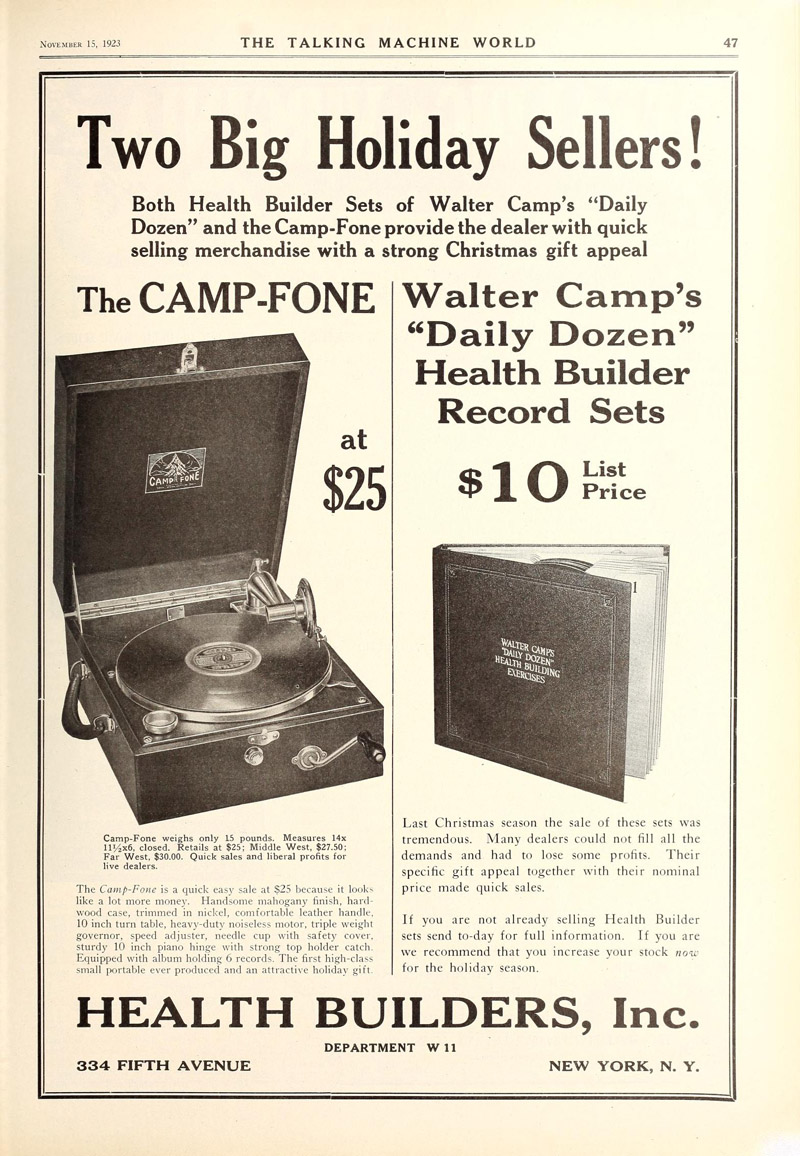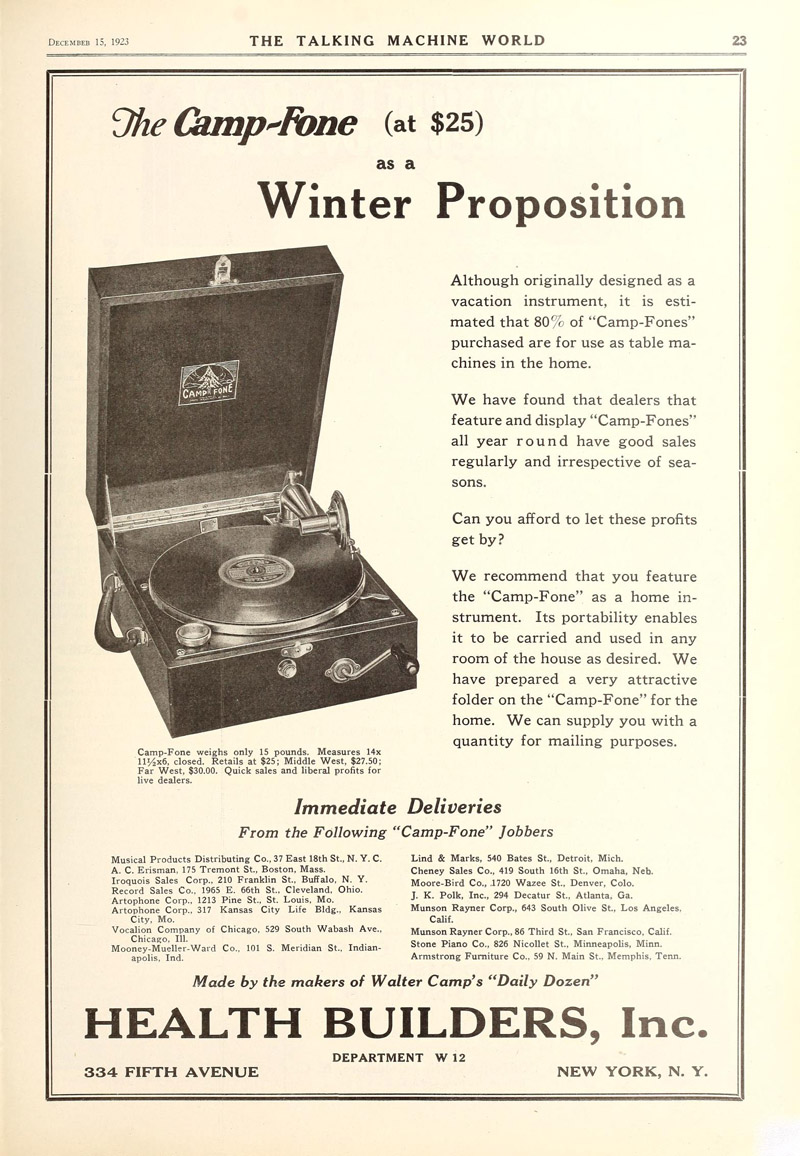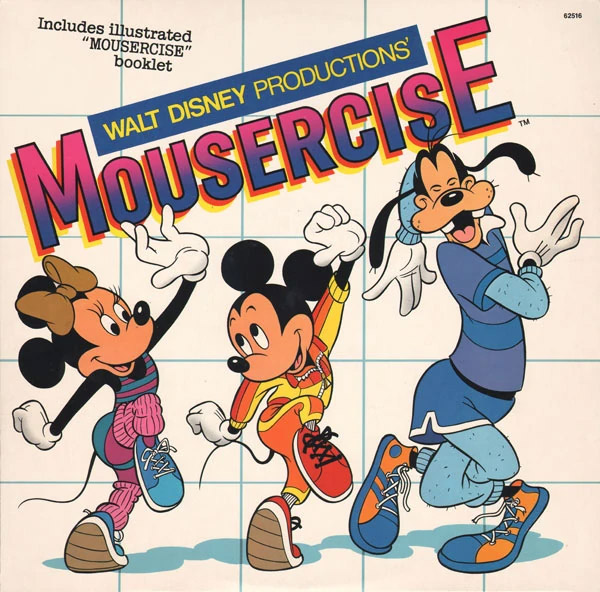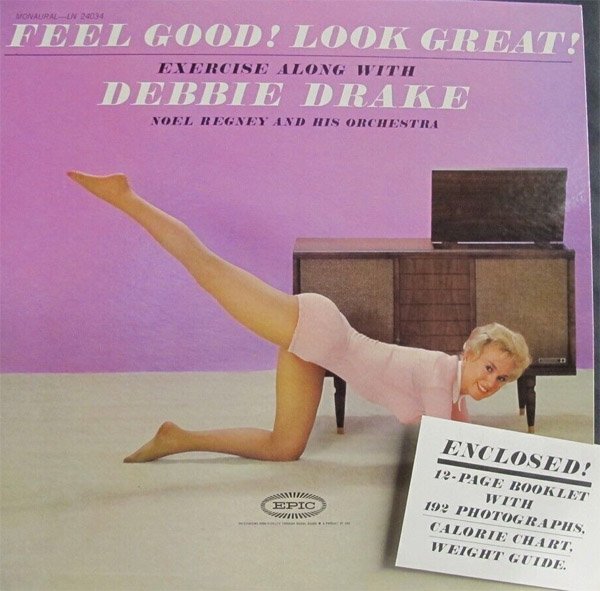Keeping Fit with the Phonograph
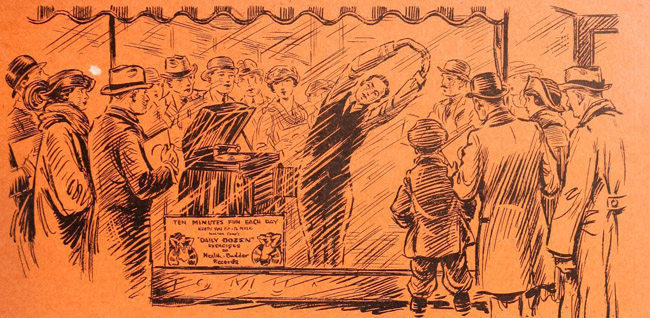
"Exercising
to Music"
By Doug Boilesen 2022
One of the novel uses of the phonograph
started in 1920 and it was based on making records which were physical
exercise programs for the home set "to music."
Keep Fit with the "health
building exercises now on phonograph records!" was the new
message of their ads. At last "a way to get real enjoyment
from exercise you need to keep fit."
In 1922 three companies in the U.S.A.
were nationally advertising their exercise programs set to "music."
Walter Camp's "Daily Dozen"
exercise records were being offered in 1921. In the January 15, 1922
issue of The Talking
Machine World Camp's
ad explained how this "popular new idea" would benefit
the public for the health and enjoyment his records would bring and
for the profit it would bring phonograph and record dealers.
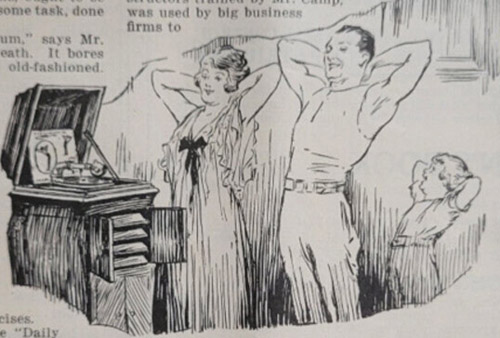
Illustration from "Walter
Camp's "DAILY DOZEN" ad
in The Outlook
Wallace S. Rogerson, President of the
Wallace Institute of Chicago, in the April 15, 1922 issue of The
Talking Machine World, wanted to make sure that phonograph dealers
and the world knew that he was the originator of this "music-method
of physical exercise." The ad also noted that over
50,000 record sets had already been sold direct by mail-order
and now dealers were getting stocked up on his records.
The Talking Machine
World , April 15, 1922
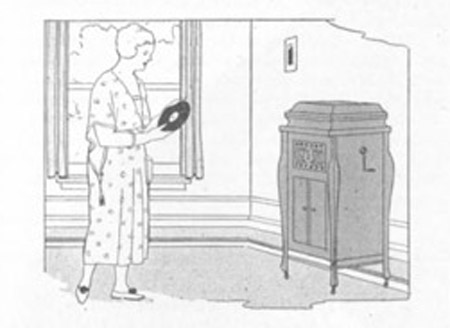
Illustration from 1922
Ladies' Home Journal Wallace ad
The third competitor in 1922 promoting
phonograph exercise records was Miss Susanna Cocroft. Cocroft published
an ad in the same issue of The Ladies' Home Journal, April
15, 1922 in which the Wallace Records were being advertised and she
was probably who Wallace was primarily referring to in warning dealers
to "decline to handle any of the pitiful substitutes being offered."
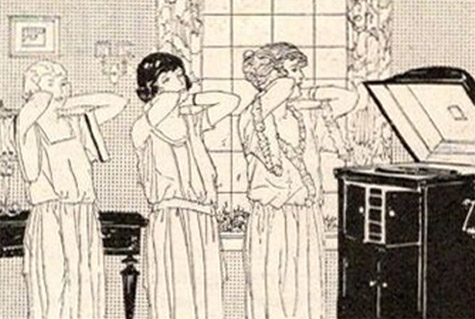
Illustration from 1922
Susanna Cocroft ad
In 1922 all three of these record-using
exercise programs included "Music" as a key part of their
ads.
Camp's ads were "Keep Fit Walter
Camp's Way -- to Music!"
Wallace's ads were "Get Thin -
to music!"
Cocroft's ads said "Reduce or Increase
Your Weight - to Music."
This gallery has six sections:
Who
was First?
1922
Ads for Exercise "to Music" Records
1923
Ads and the Introduction of the Portable "Camp-Fone" Phonograph
Post
1923 - Camp, Rogerson and Cocroft
The
Phonograph and Multi-format Examples of Exercising Programs "Recorded"
for Home Use
HISTORY
DETECTIVES - Fitness, Flappers and Phonograph Records
Who
was First?
Walter Camp's "Daily
Dozen" was an exercise program that was well-known for its use
in the training of American soldiers for WWI. There are examples as
early as 1921 of Camp and "Health Builders" advertising
his program using records with 1921 copyrights.
Likewise, Susanne Cocroft
had been an author and a promoter for women to "Be Well"
since the beginning of the twentieth century but she didn't introduce
her record and its music supported program until 1922.
The "first" of
its kind, therefore, belongs to Wallace Rogerson's use of music for
his exercise records with "Wallace"
records having copyrights of 1920 and 1921 and his patent taken out
on November 14, 1922.
According to Jim Middleton,
a collector of 1920's Camp and Wallace exercise records who was interviewed
on the PBS segment of the
History Detectives episode about Wallace (see
below), the "Wallace" exercise records were copyrighted
as the first physical fitness records in 1920. Wallace’s first set
of exercise records were pressed by the Columbia Phonograph Company
and sold via mail order. (See Note The Notes: An Illustrated History
of the Columbia Record Label 1901-1958 by Michael W. Sherman and
Kurt Nauck, Monarch Record Enterprises,
1998, p. 56).
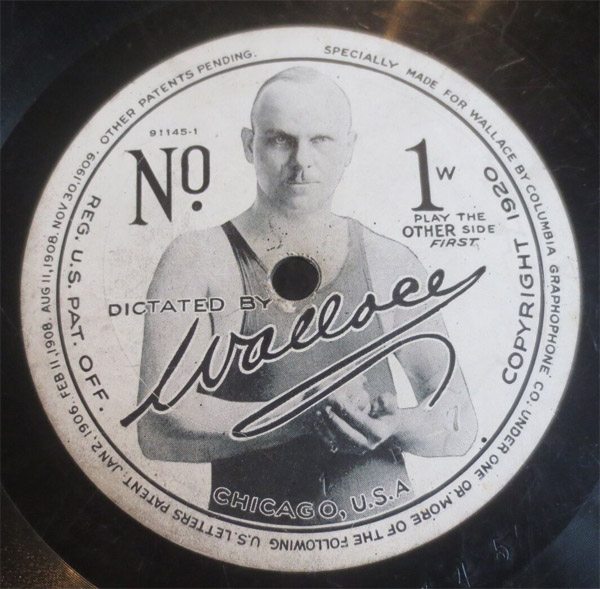
1920 Record Dictated
by Wallace: Columbia Custom Catalog: No. 1 (91145-1/2)
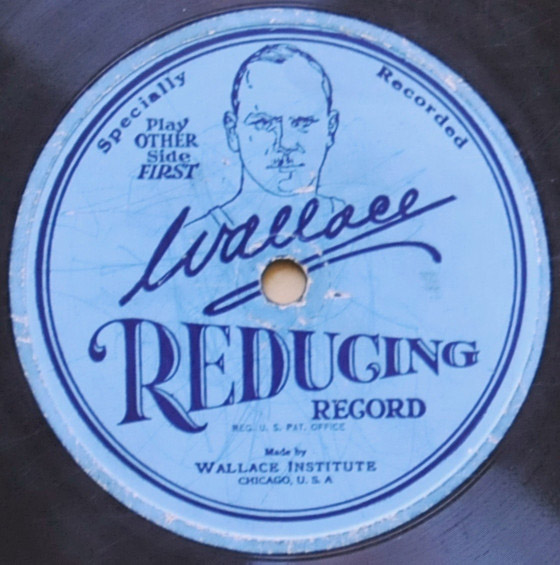
See
Discogs for other examples of Wallace Records.
"Camp’s record set,
marketed by the Health Builders Company in New York, appeared almost
immediately after Rogerson’s and sold by both mail order and in stores.
The five records consisted of rousing band marches over which Camp
shouted exercise commands." (1)
The following "Wallace"
ad in The Pictorial Review of December 1920 is the earliest
example in this Phonographia Gallery of a phonograph record set to
music being advertised as part of an exercise program. This exercising
record, according to Wallace S. Rogerson's ad, was designed to help
women lose weight "at home with a talking machine!"

The Pictorial Review of December
1920
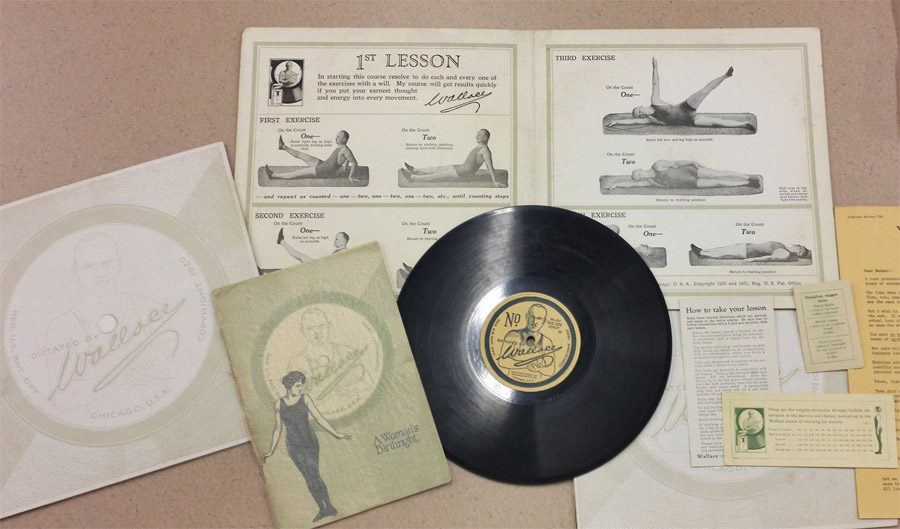
Wallace's Record with its
respective 1st Lesson Instructions from the Wallace Set of Exercise
Records, Copyright 1920. Reg. U.S. Pat. Office. (Courtesy Kenosha
History Center - Women's Collection)

"Don't go to a gymnasium..."
use the famous coach's "Exercises Now on Phonograph Records!"
The Outlook, 1921(?).
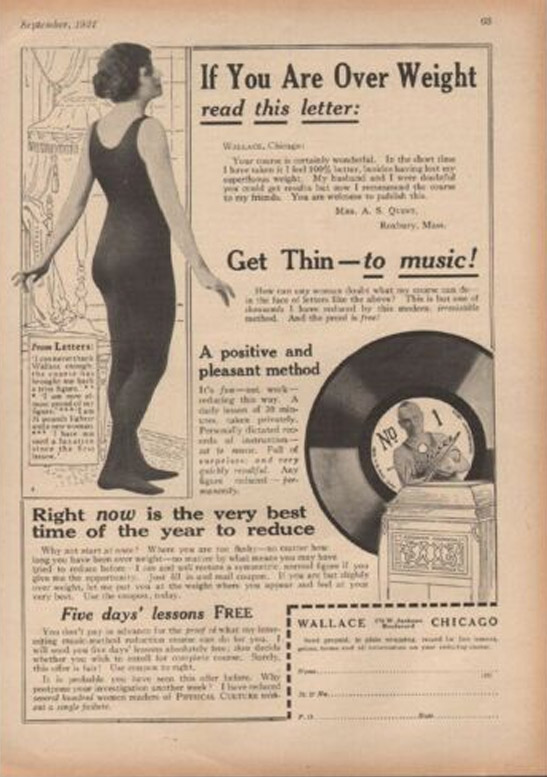
September, 1921 (unknown
magazine)
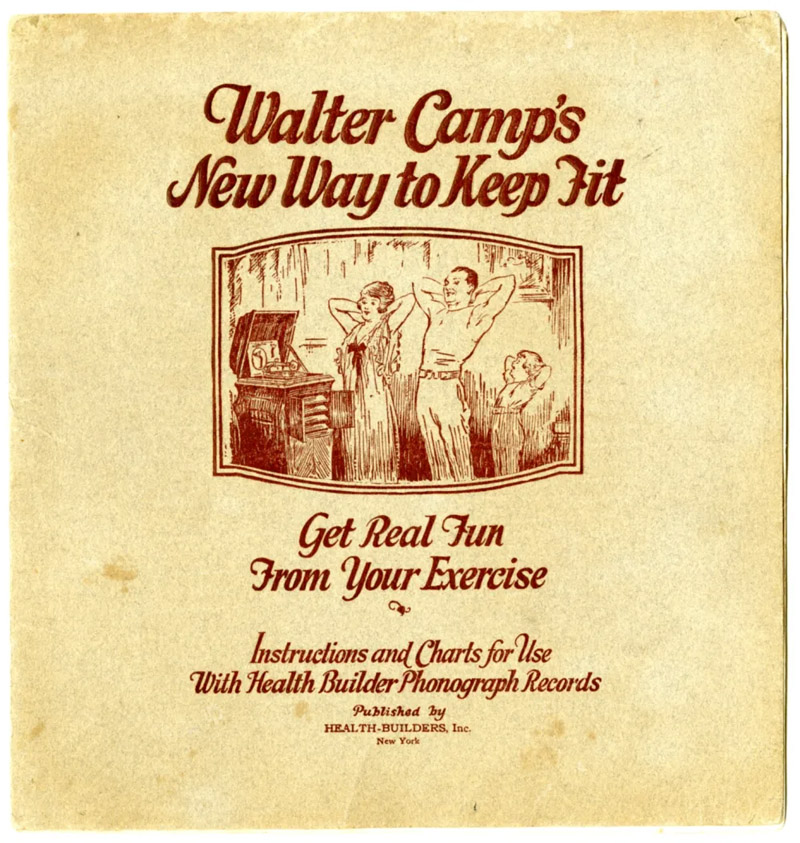
Walter Camp's New Way to Keep Fit,
Manual with Instructions and Charts which accompanied records, 1921
(Courtesy Printmag.com).
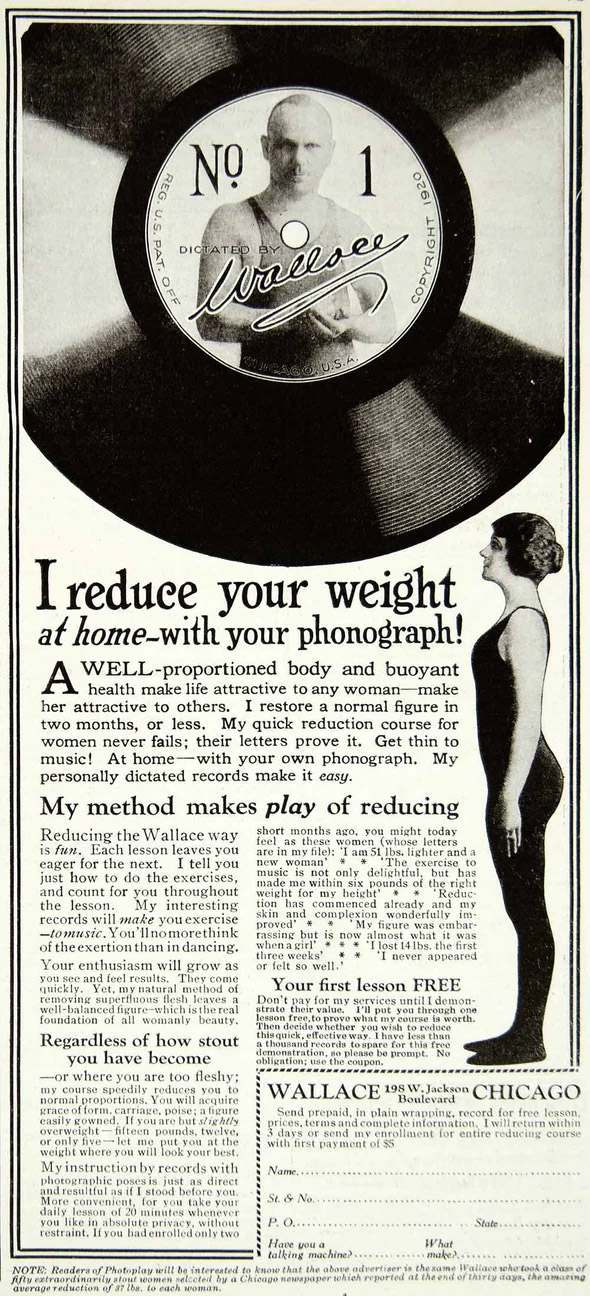
Wallace Ad to "reduce your weight
at home - with your phonograph!" 1921 (Courtesy Period
Paper)
Camp and Wallace would both have advertisements
in August 1921 national magazines.
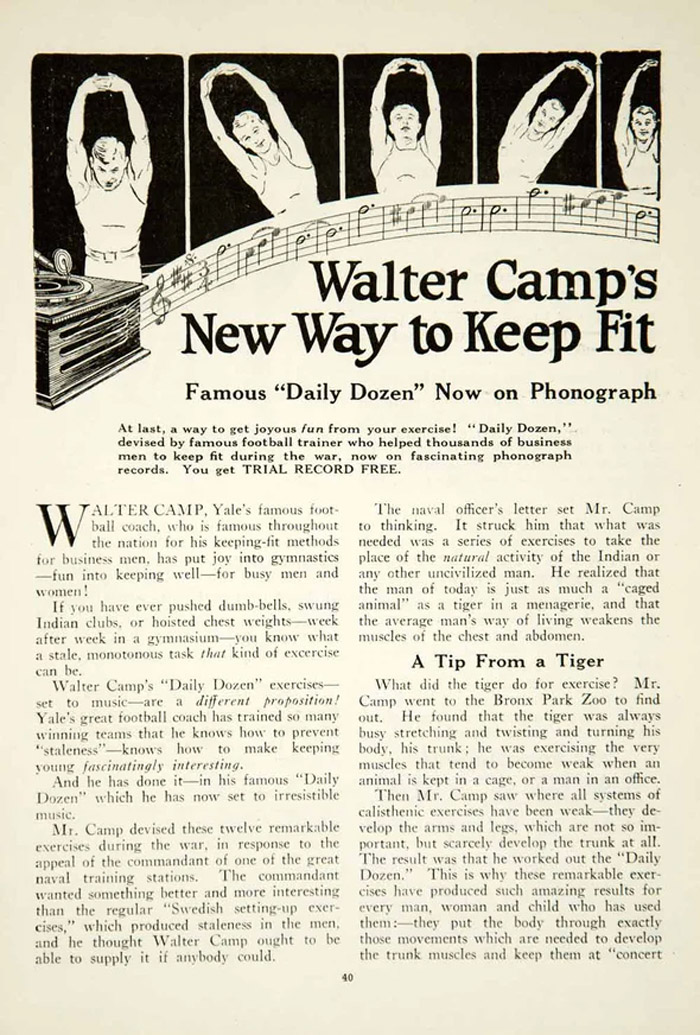
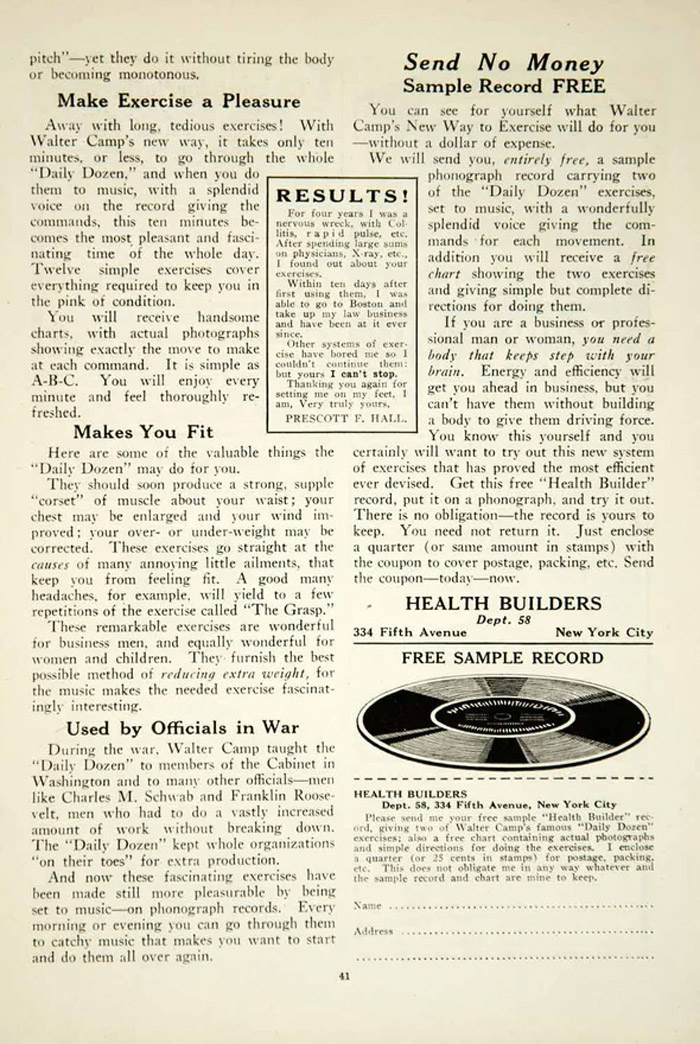
Walter Camp's New Way
to Keep Fit, 1921 (Courtesy Period
Paper)
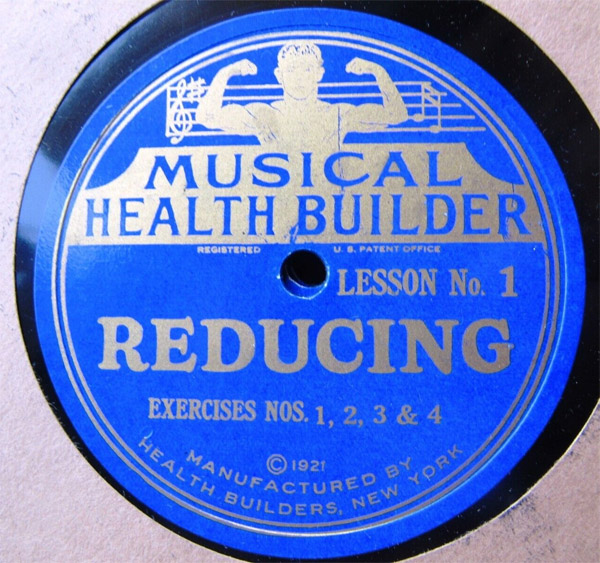
Walter Camp Musical Health
Builder - Reducing Exercises Record Lesson 1, Copyright 1921, Manufactured
by the HEALTH BUILDERS, New York, 1922.
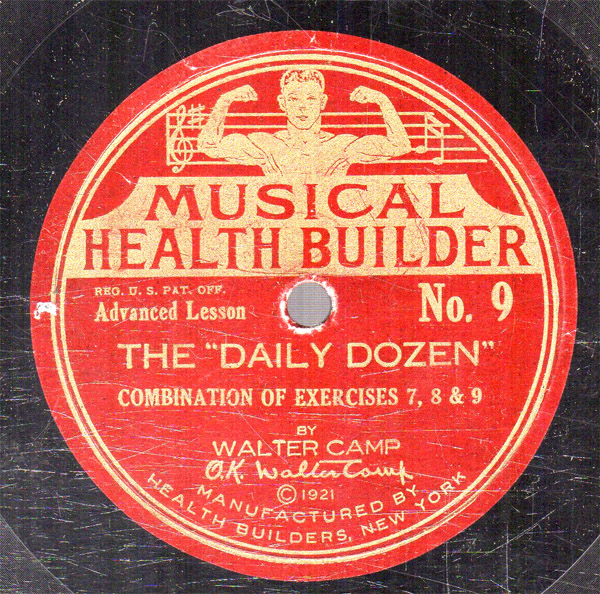
Walter Camp's Musical Health
Builder - The "Daily Dozen" Advanced Lesson No. 9, Copyright
1921, Manufactured by the HEALTH BUILDERS, New York, 1922.
1922
Ads for Exercise "to Music" Records
The following are 1922 advertisements
and ephemera for the exercising programs using records with music
promoted by Walter Camp, Wallace Rogerson, and Susanna Cocroft. This
would apparently be the only year that Cocroft nationally advertised
her recorded exercise program.
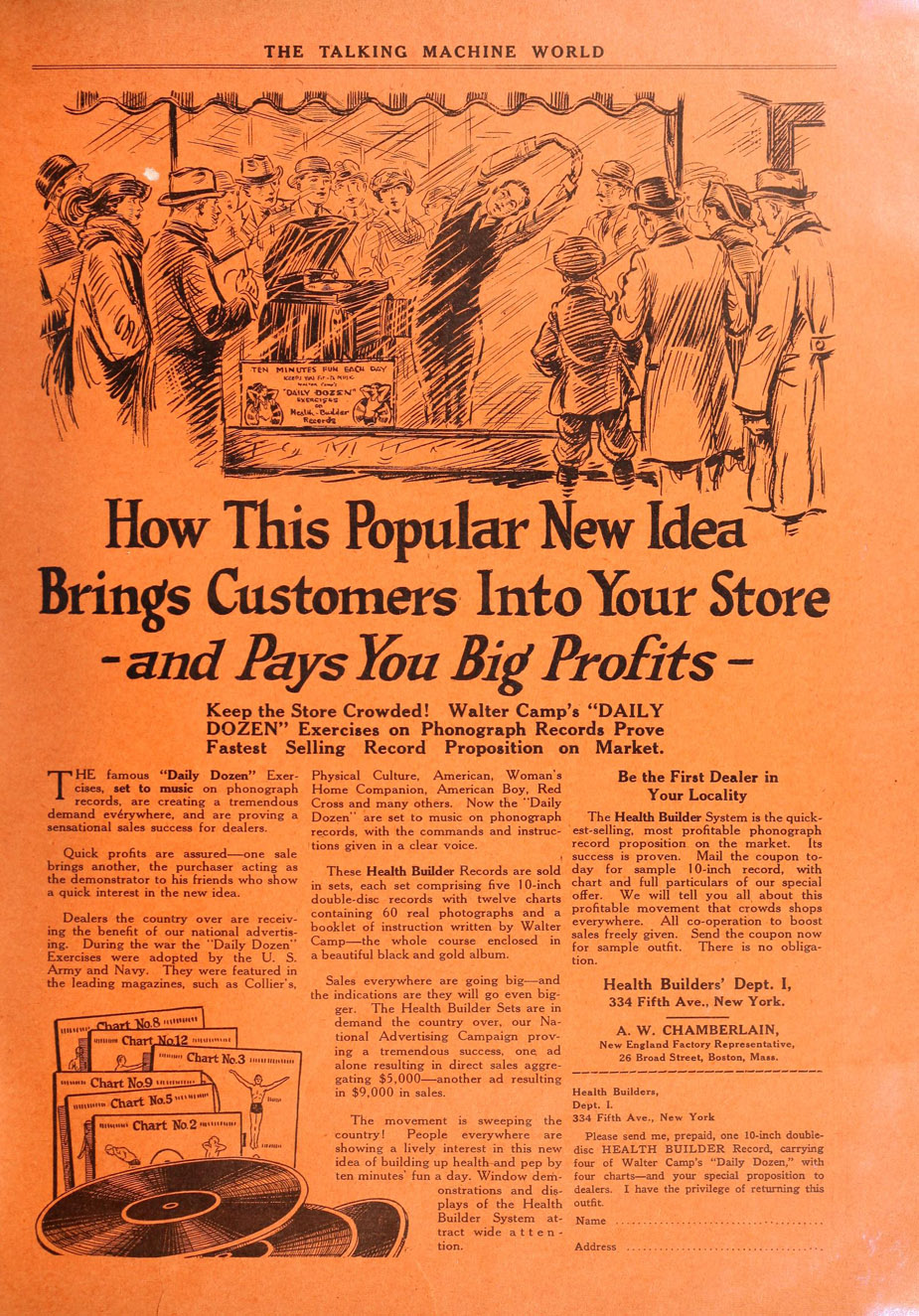
"Walter Camp's "DAILY
DOZEN" Exercises on Phonograph Records," The Talking
Machine World, January 15, 1922.
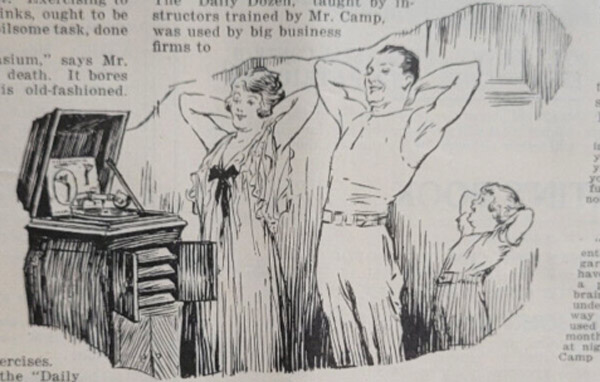
Illustration from "Walter
Camp's "DAILY DOZEN" ad
in The Outlook
"Get Thin to
Music" - Wallace
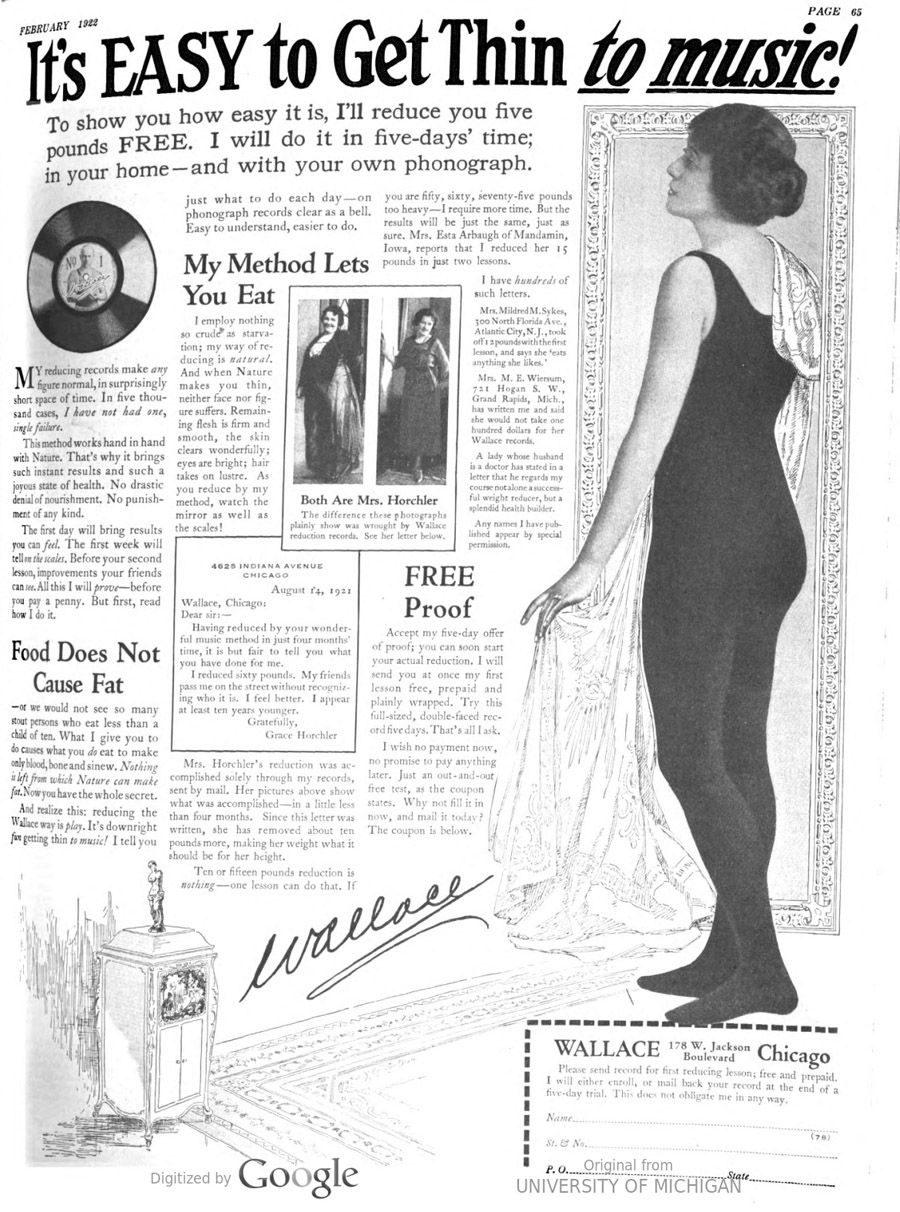
Wallace ad, Women's
Home Companion, February,
1922 p. 65.
"Be Well..."
-- Susanna Cocroft

Cocroft's "Be Well"
ad but no phonograph record mentioned which would indicate Cocroft
hadn't introduced records to her program yet), Women's
Home Companion, February,
1922 p. 100.
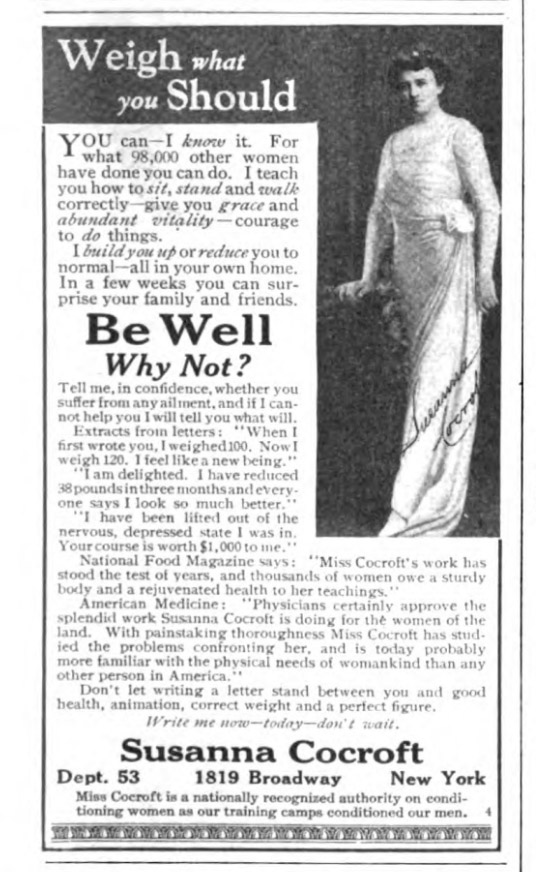
"Miss Cocroft is a
nationally recognized authority on conditioning women..." (but
no mention of records), The Delineator, February, 1922 (Courtesy
Michigan State University).
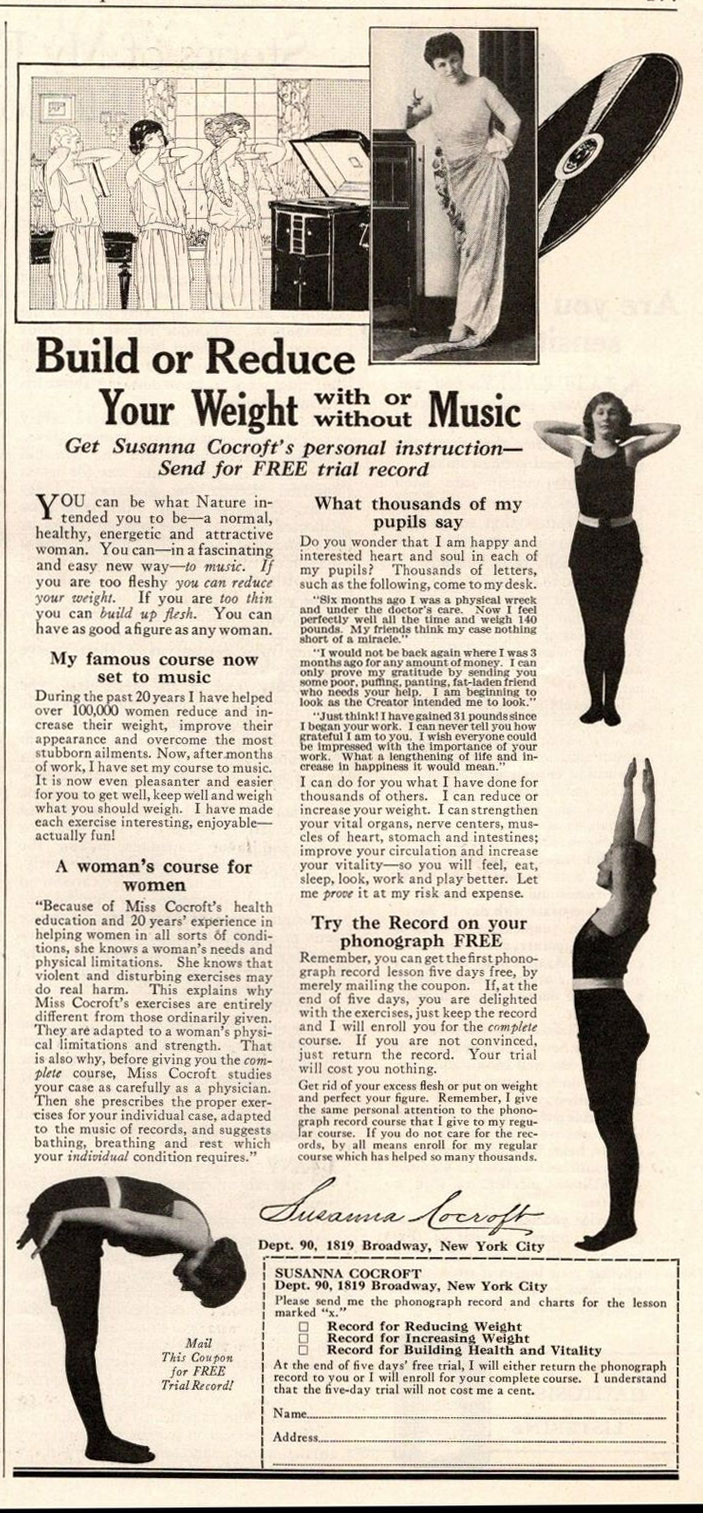
Cocroft ad (with or without
music), 1922 p. 177
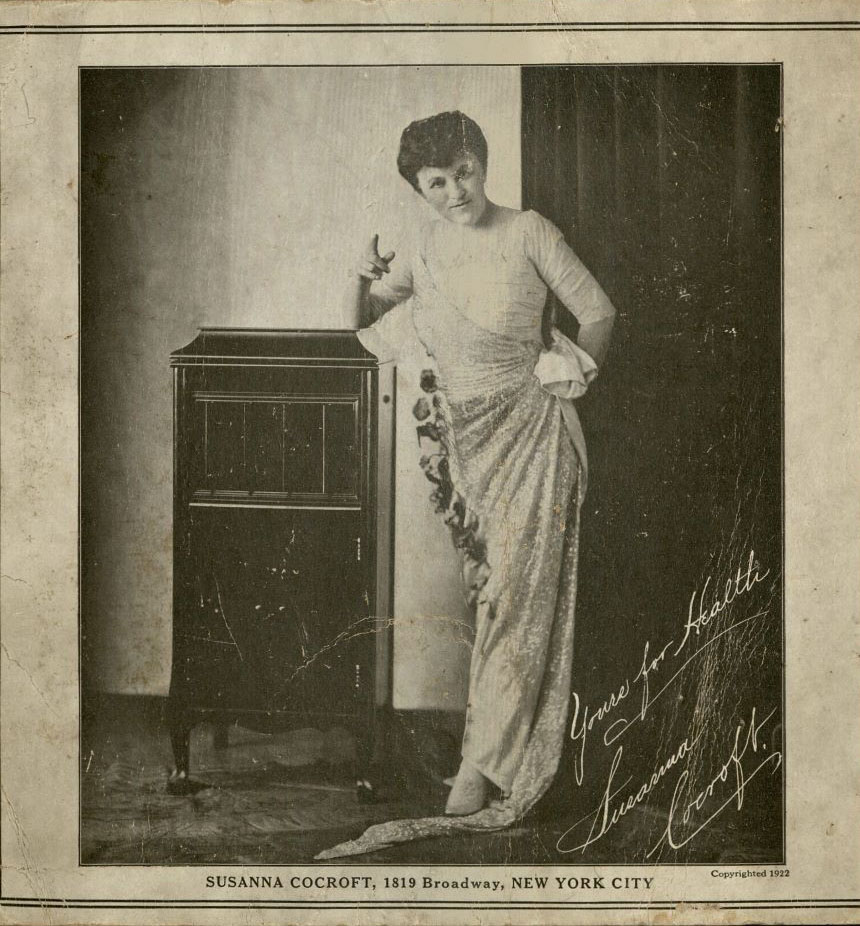
Susanna Cocroft Record
Album cover photograph, copyrighted 1922 (Courtesy CSUN
University Library)
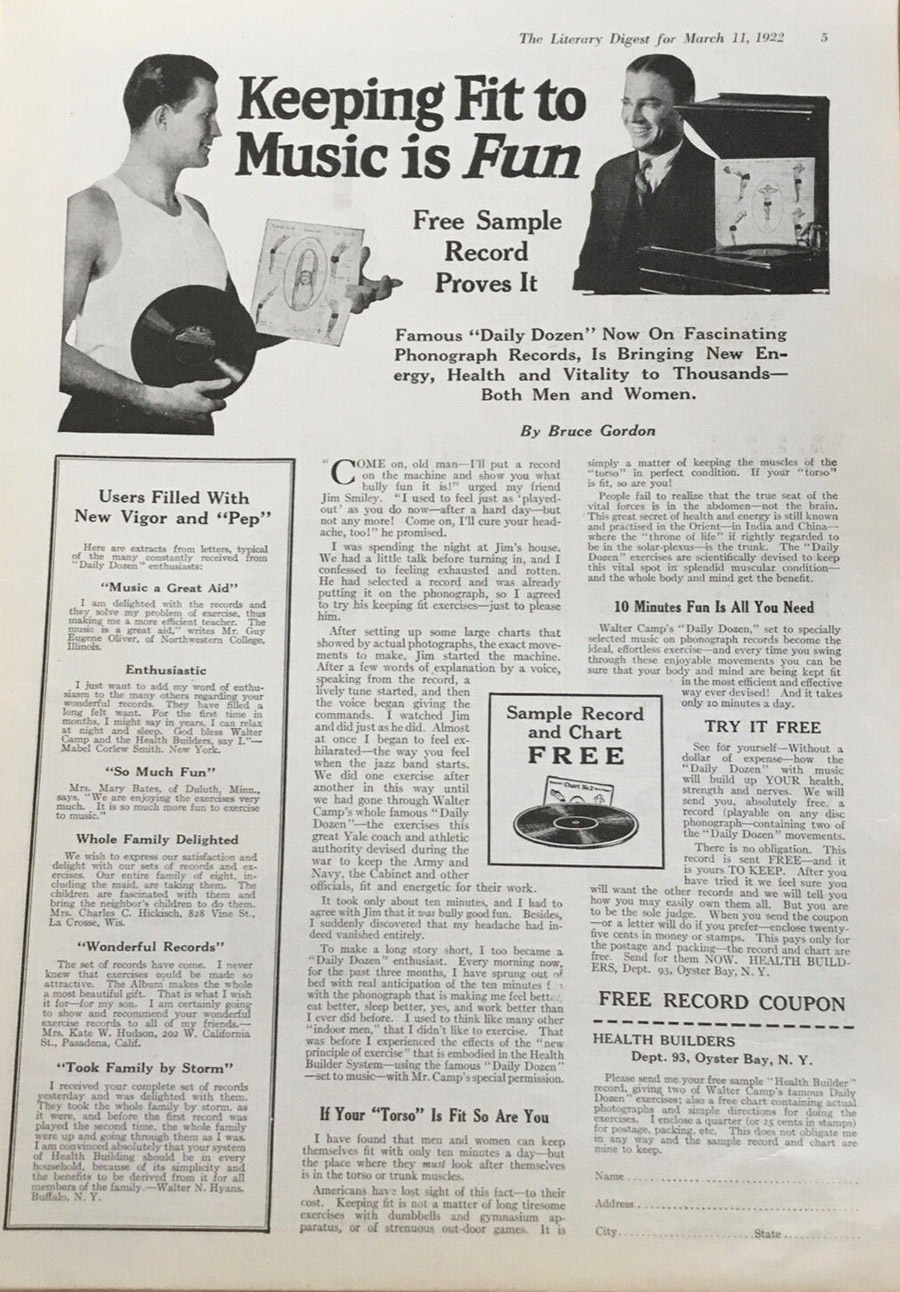
"Keeping Fit to Music is Fun!,"
The Literary Digest for March 11, 1922.
"Walter Camp's "Daily
Dozen," set to specially selected music on phonograph records..."
"Get Thin to Music"
In an article in Talking Machine
World and in a four page promotional insert in the April 1922
edition of TMW the "Wallace reducing records" were said
to be "scientifically sound" and any similiar records
were to be considered "imitations which will all be prosecuted
with vigor."
Walter Camp was surely considered
a respected expert in physical exercise but Wallace seems to have
considered his "music-method" to be proprietary. Cocroft,
on the other hand, had just started her national advertising of
her weight program "set to music on phonograph records"
in 1922 (possibly March) and it's likely that Wallace was referring
to Cocroft when he urged dealers to decline to handle the "pitiful
substitutes being offered." Both Cocroft and Wallace had ads
in The Ladies' Home Journal of April 1922.
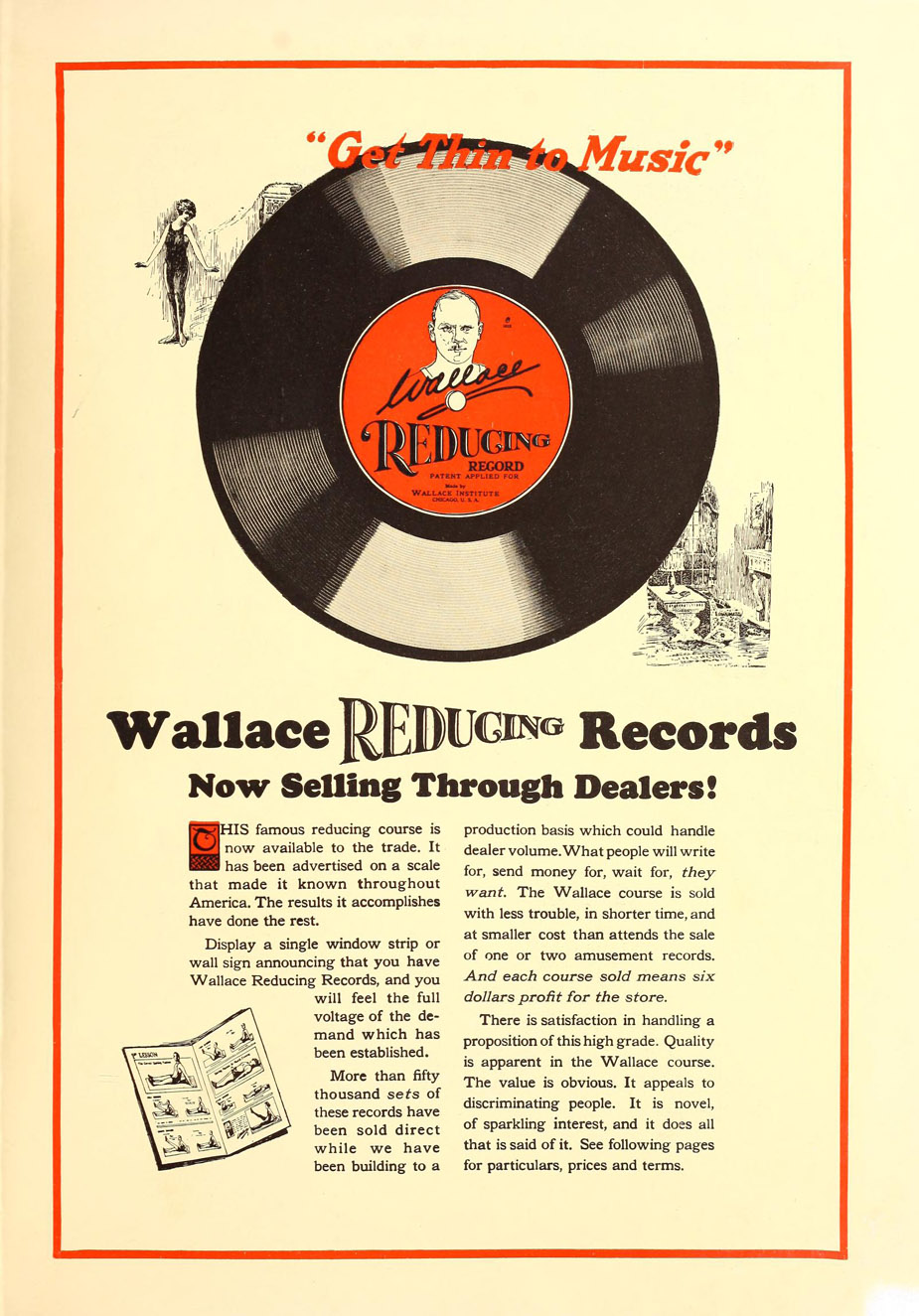
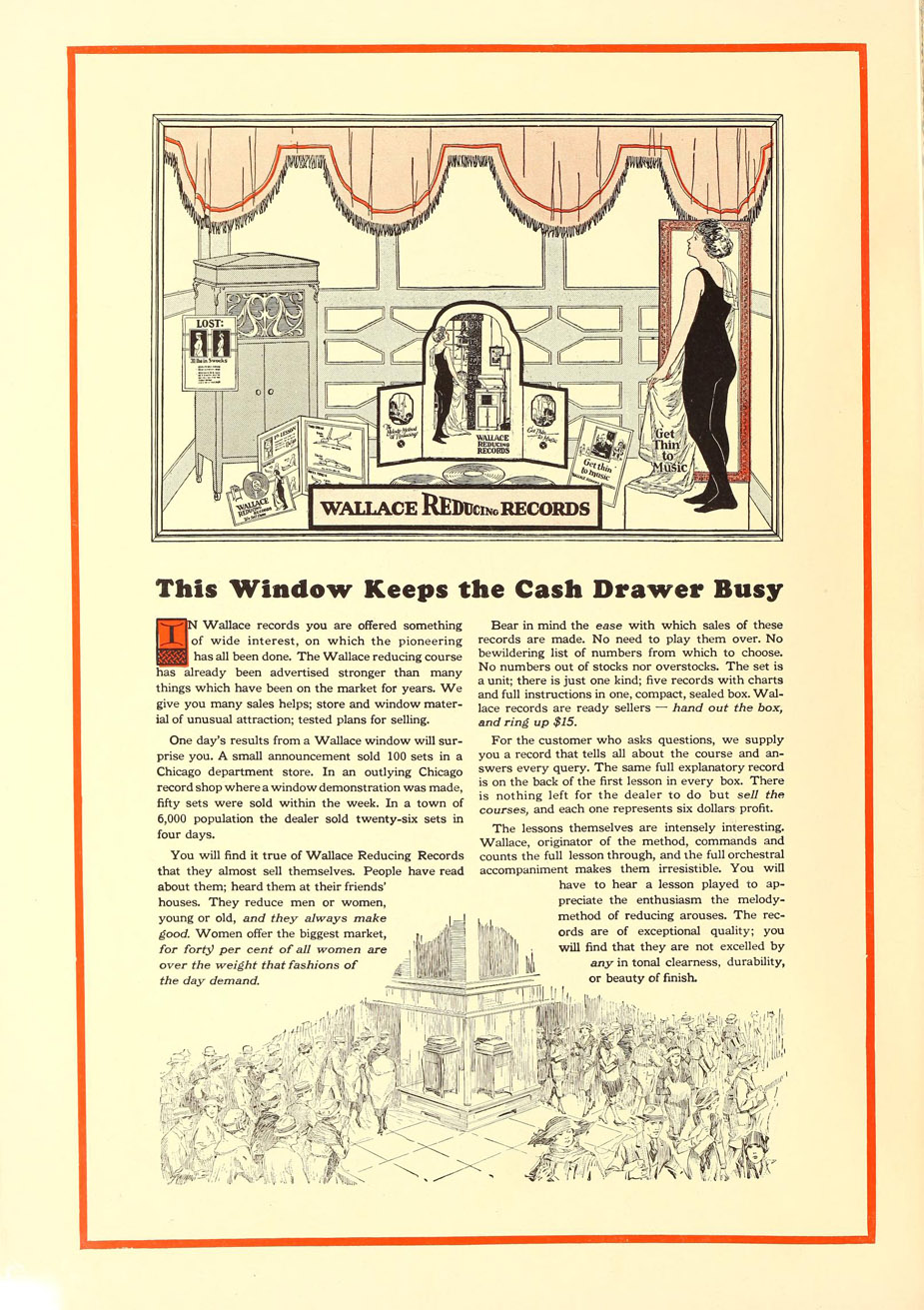
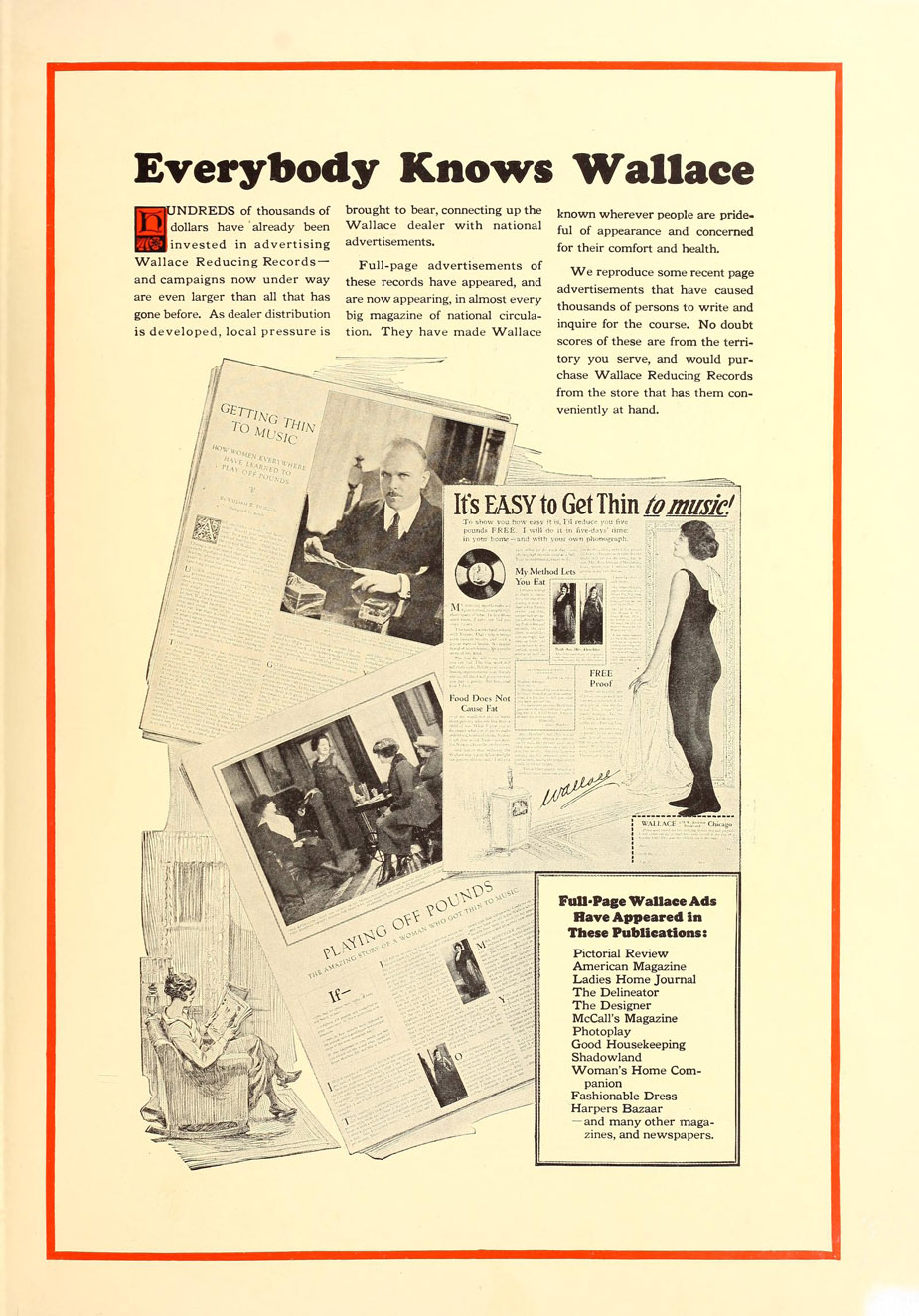

The Talking Machine World ,
April 15, 1922, p. 19D

Wallace ad, The
Ladies' Home Journal, April,
1922 p. 57 (Courtesy University of Michigan)

Miss Susanna Cocroft ad, The
Ladies' Home Journal, April,
1922 p. 155 quarter-page ad (Courtesy University of Michigan). This
April ad seems to be one of the earliest examples of Cocroft offering
a record for her "weigh what you should" program (i.e.,
reducing weight or increasing weight).
Wallace ad, The
Ladies' Home Journal, May,
1922 p. 171
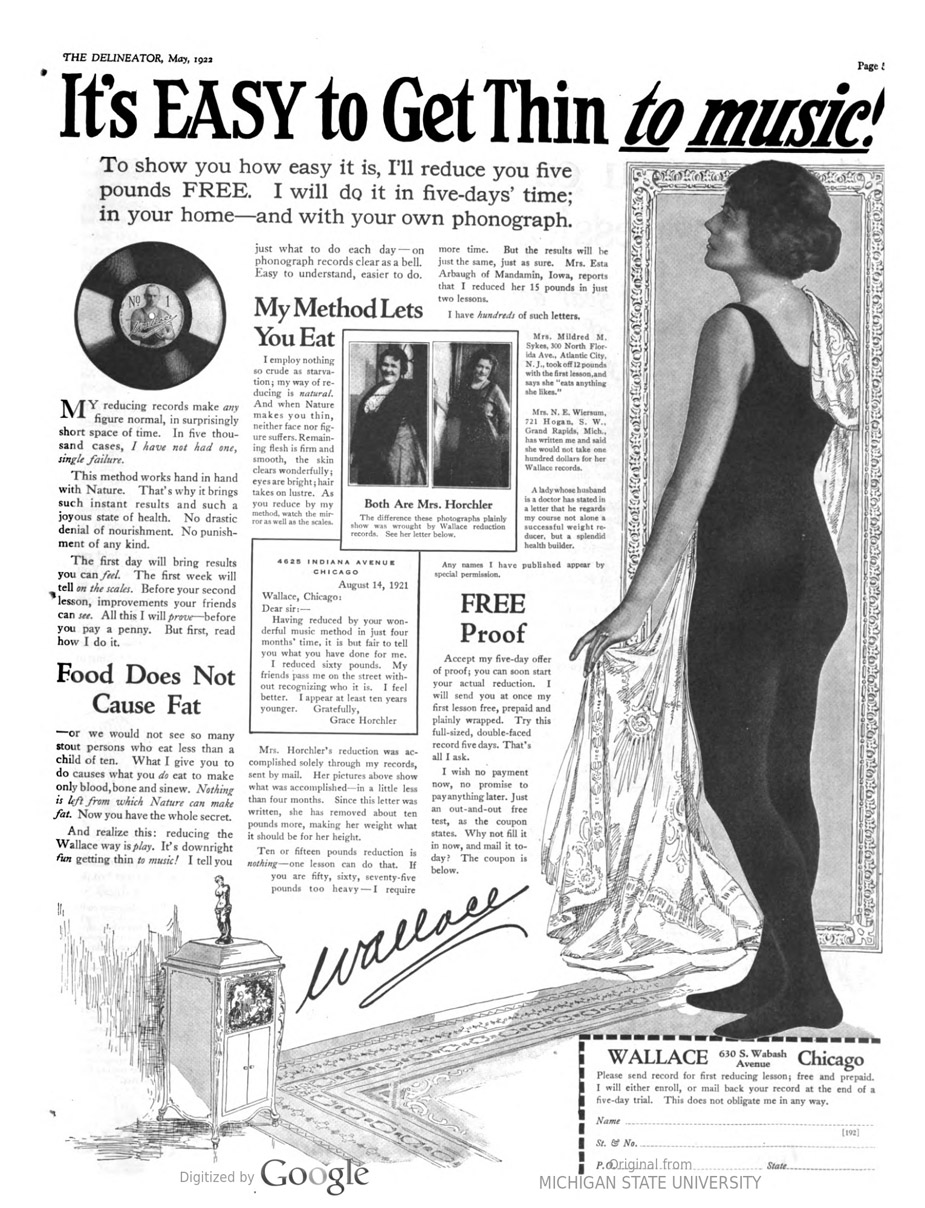
Wallace - "It's Easy to Get Thin
-- To Music!" The
Delineator, May, 1922 p.
55
Miss Susanna Cocroft ad, The
Ladies' Home Journal, May,
1922 p. 49 half-page ad (Courtesy University of Michigan)
Miss Susanna Cocroft ad, The
Ladies' Home Journal, June,
1922 p. 49, half-page ad (Courtesy University of Michigan).

Miss Susanna Cocroft ad, The
Ladies' Home Journal, October,
1922 p. 147 quarter-page ad (Courtesy University of Michigan)
Miss Susanna Cocroft "Be Well"
with phonograph record ad, The
Ladies' Home Journal, November,
1922 p. 54, half-page ad (Courtesy University of Michigan).
Wallace ad, The
Ladies' Home Journal, November,
1922 p. 121 (Courtesy University of Michigan).
Wallace ad, The
Ladies' Home Journal, December,
1922 p. 155 (Courtesy University of Michigan).
Keep Fit. Walter Camp's Way -- to
Music!
"Free Health Builder Record,"
American Magazine, 1922, p.
146
1923
Ads and the Introduction of the Portable "Camp-Fone" Phonograph
In 1923 the national competition of
exercise programs set to music on talking machines became a two-person
match between the records offered by Walter Camp and Wallace Rogerson.
Cocroft had made a brief run for that market in the last half of
1922 but her experiment using the talking machine and its records
for her 'program' ended in 1923. As historian Lynn Peril has written
Crocroft's overall influence was in decline:
"Cocroft’s influence perhaps
reached a zenith in the summer of 1918... Perhaps it was the failure
of the Corps, or the death of her husband in 1923, or simply age
(she turned 58 in 1920), but the wind seems to have gone out of
Cocroft’s sails in the new decade." (2)
Lynn Peril, iPlanet of Peril, July 8, 2017).
In contrast, Walter Camp's "
Daily Dozen" talking machine records (made by "Health
Builder, Inc.") were to get a boost in 1923 with Health Builder
entering the talking machine field by introducing their own portable
phonograph which they named the "Camp-Fone." Advertisements
in April 1923 would point out that "The Camp-Fone
appeals both to the Walter-Camp 'Fans," and to all outdoor
camp enthusiasts, as well. Present owners require the Camp-Fone
so that their daily exercises will not be interrupted when they
go to the country."
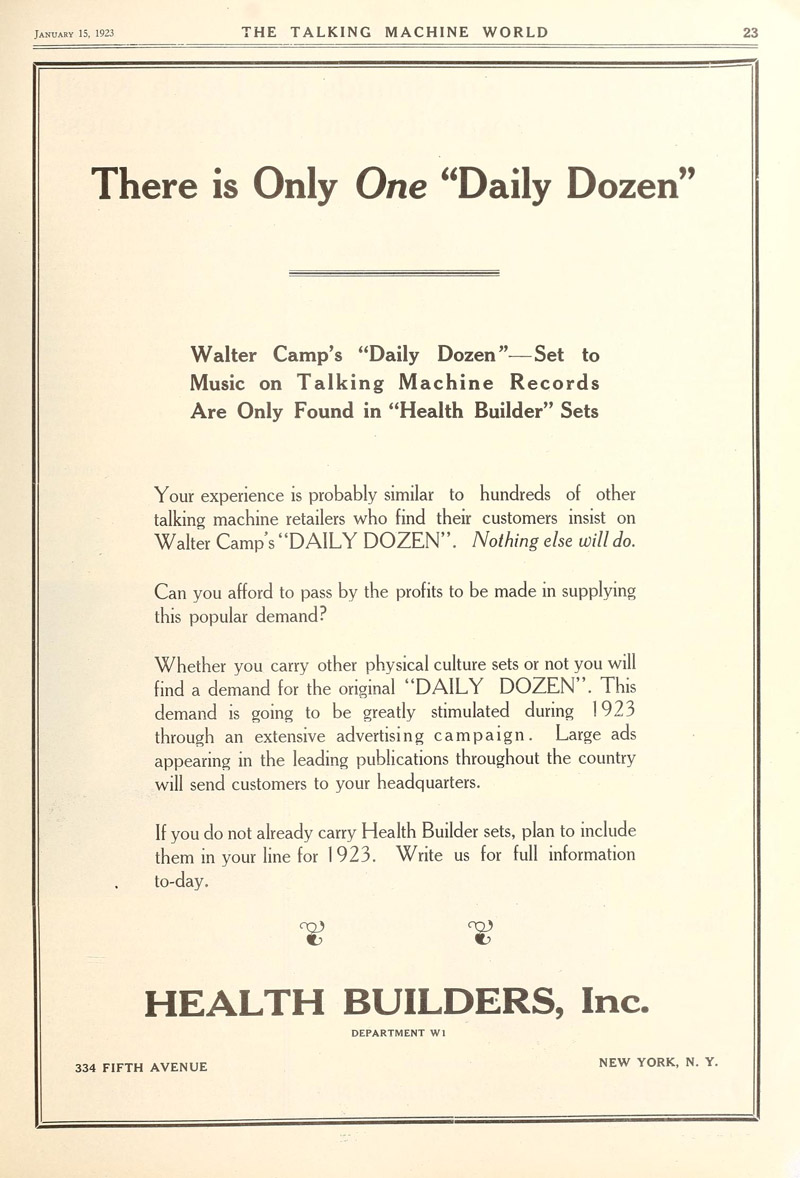
The Talking Machine
World, January 15, 1923
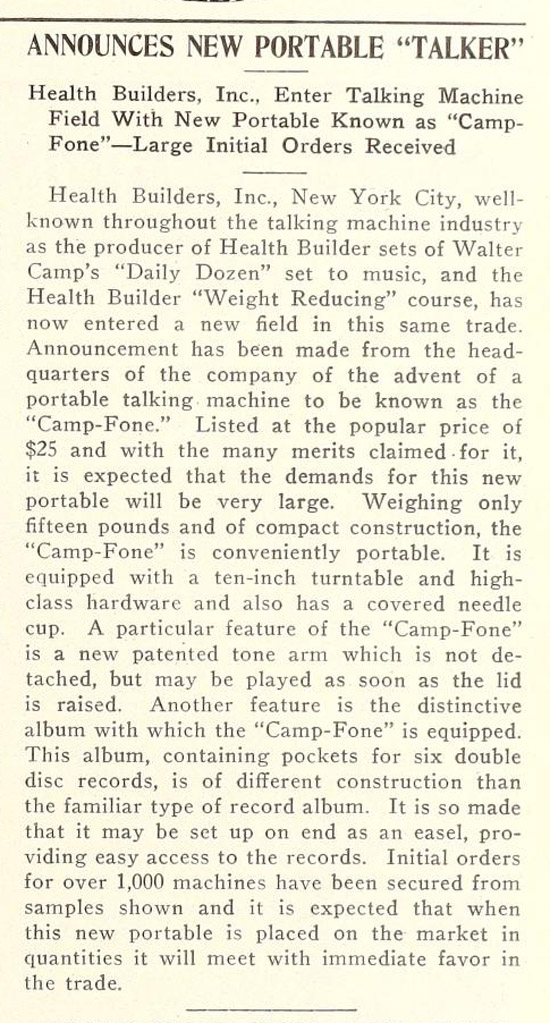
Announcement of the
"Camp-Fone" by Health Builders, Inc. (makers of Walter
Camp's "Daily Dozen" set to music record sets), The
Talking Machine World, April 15, 1923, p. 73
The Camp-Fone for Walter Camp's
"The Daily Dozen" set to music records, The Talking
Machine World, April 15, 1923
The advertisement notes that besides
appealing "to the Walter-Camp 'Fans" its small
size and light weight make it "popular in the small apartment.
Ideal for dancing, boatiing parties, picnics, auto trips, and general
vacationing."
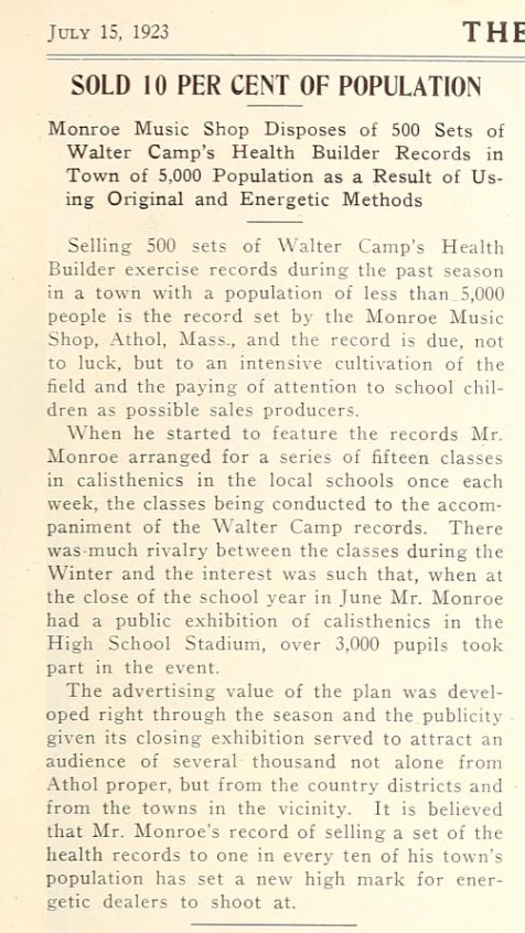
The Talking Machine
World, July 15, 1923.
According to this July 15th article
ten percent of the population of Athol, Mass. own Walter Camp's
Health Builder exercise records. The trade magazine closed by noting
this achievement is "a new high mark for energetic dealers
to shoot at."
The Camp-Fone for Walter Camp's
"The Daily Dozen" Health Builder Record Sets, The
Talking Machine World, November 15, 1923
The Camp-Fone as
a Winter Proposition, The Talking Machine World, December
15, 1923
Post 1923 - Camp,
Rogerson and Cocroft
Walter Camp died unexpected of a
heart attack in 1925. "Health Builders, Inc.," the company
that made Camp's records and took over the copyright of "The
Daily Dozen," continued promoting Camp's records, "The
Daily Dozen" program and the "Camp-Fone."
Wallace Rogerson's exercise records
and books continued to be popular and at the time of his death
in 1943 his Chicago
Tribune
obituary noted that "millions of recordings have been
distributed." He was involved with radio for many years and
conducted the Chicago WGN
radio program with its musical background "Keep
Fit to Music."
Susanna Cocroft's brief experiment
with the phonograph and her "reduce or increase your weight"
management course "with or without records" appears
to have essentially stopped in 1923.
Susanna Cocroft died on December
16, 1940.
The Phonograph
and multi-format examples of exercising programs "recorded"
for home use.
Exercise recordings would continue
to be produced throughout the decades on 78's, LPs (33 1/3), 45
rpms, cassette tapes, Betamax tapes, VHS tapes, LaserDiscs, CEDs
(RCA SelectaVision), CDs, DVDs, and streaming from the intranet
(e.g., Roku, Amazon, YouTube, etc.).
FACTOLA: Jane Fonda has the
most examples of different media formats for a recorded workout
program (all of the above except 45 & 78 rpm).
Exercise Along with Debbie Drake,
EPIC Monaural LN 24034, 1963 (FP1513)

Jane Fonda's Workout,
LP, 1981 Columbia Records – CX2 38054 (double album) and Columbia
Records – C 38054
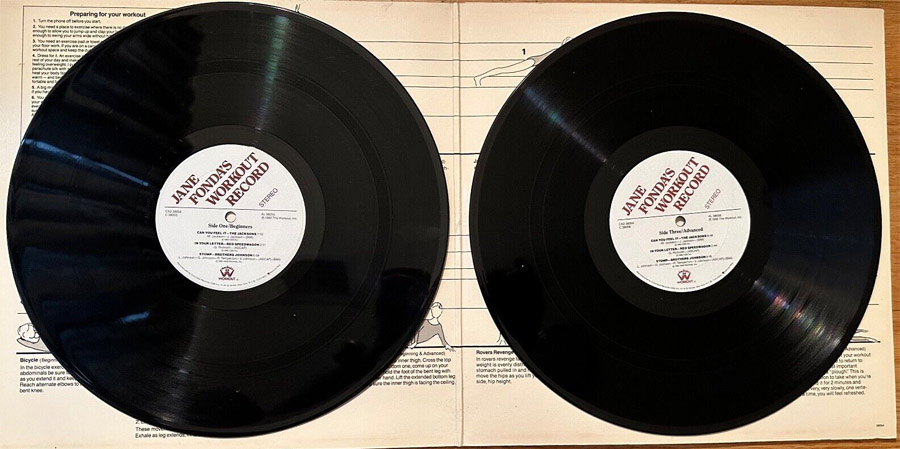
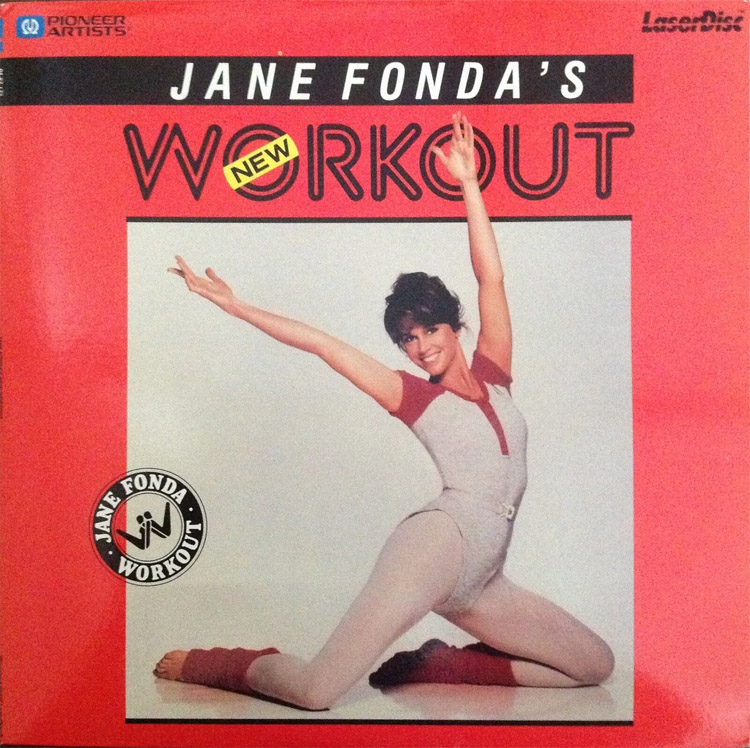
Jane Fonda's Workout, Pioneer
Artists LaserDisc, 1982
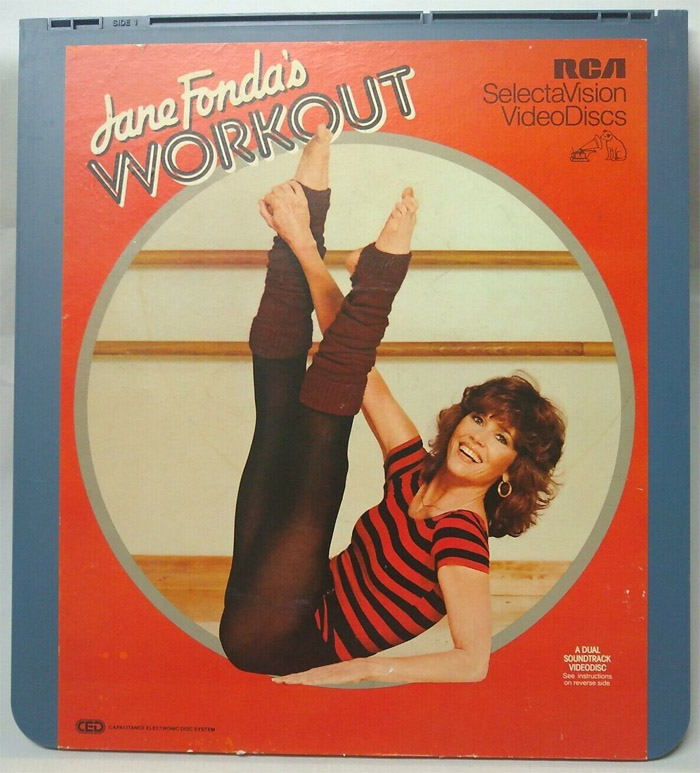
Jane Fonda's Workout, RCA SelectaVision
VideoDiscs (CED), 1982
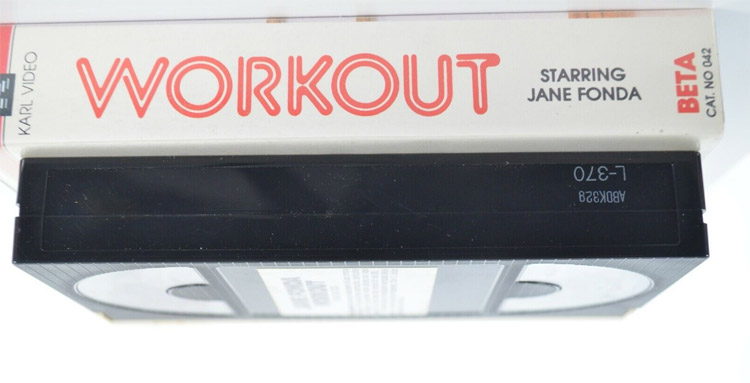
Jane Fonda's Workout, Karl Video,
Betamax, 1982
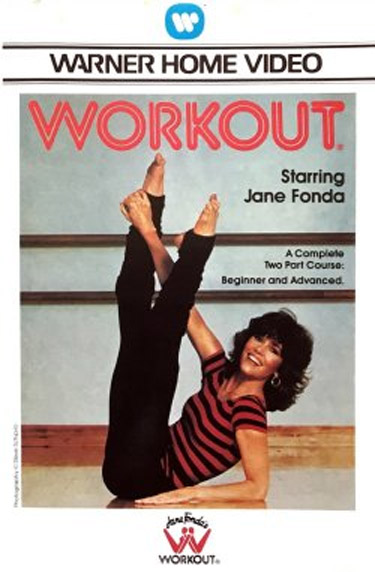
Jane Fonda's Workout, Warner
Home Video, VHS, 1982
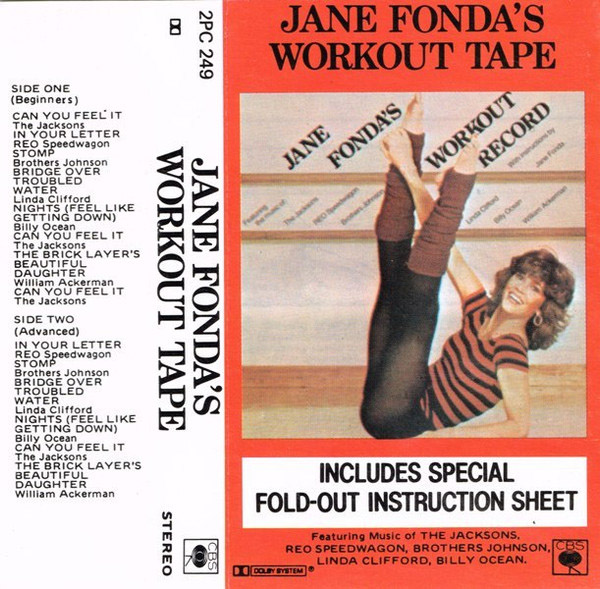
Jane Fonda's Workout, Columbia
(CBS) Cassette Tape, 1982
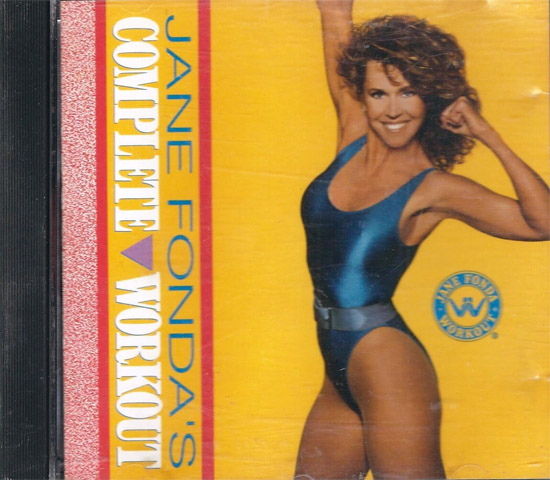
Jane Fonda's Complete Workout,
Warner Bros. CD, 1989
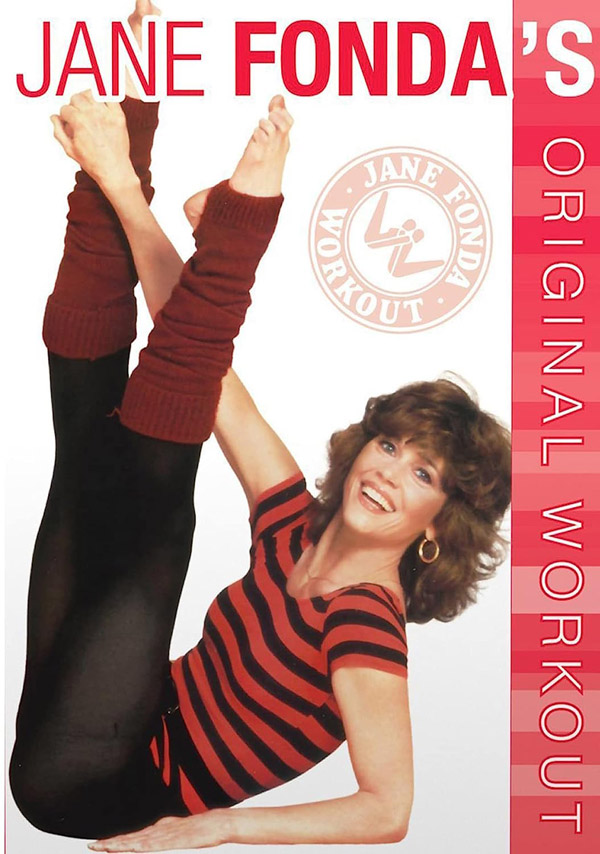
Jane Fonda's Original Workout remastered
for DVD, A Lightyear Entertainment Release, ©1982, 2014
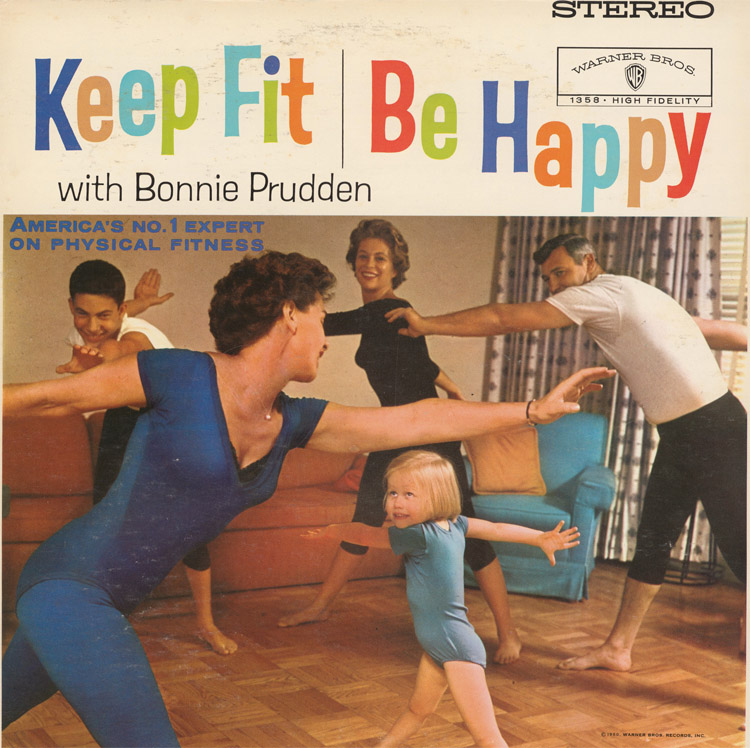
LISTEN
to Keep Fit Be Happy with
Bonnie Prudden, Warner Bros. Records, WS 1358, 1959
1982 Mousercise Vinyl Record Album,
Walt Disney Productions (FP1235)

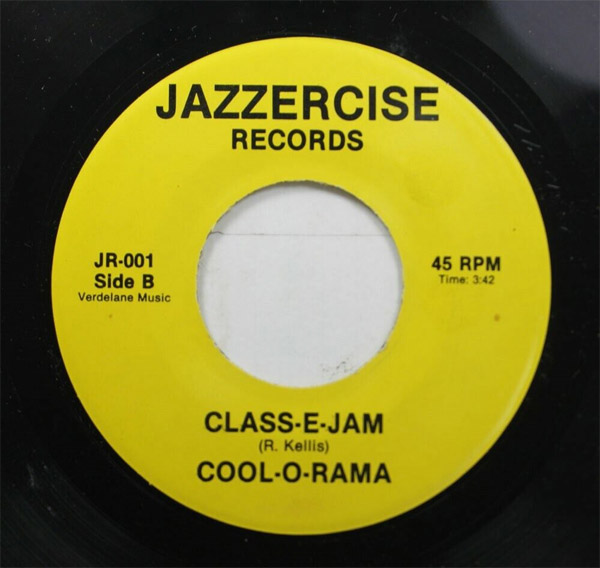
Jazzercise Records, Verdelane Music
45 RPM, 1988 JR-001
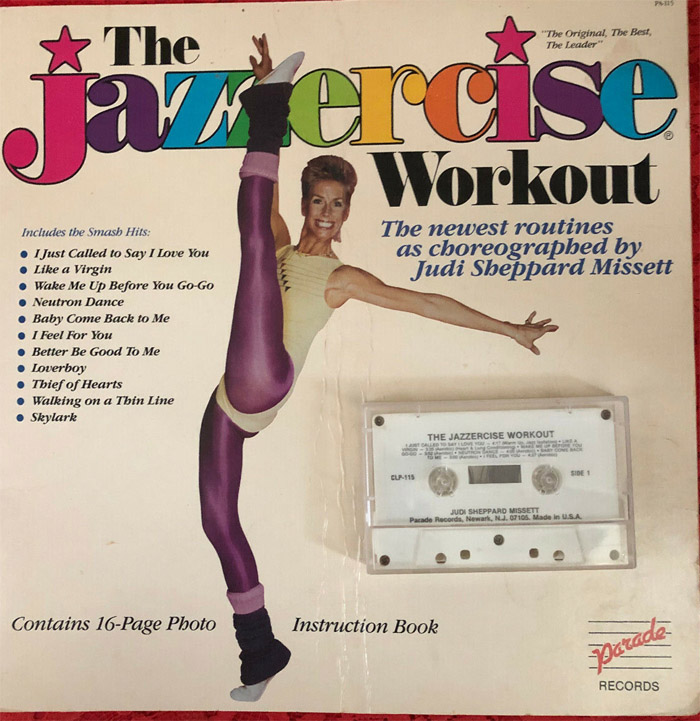
The Jazzercise Workout, Parade Records,
Cassette Tape, 1986 CLP-115 and LP PA-115
The voice on these
78 rpm records is the grandfather our contributor never met. The
1920's albums play music with Wallace Rogerson giving exercise instructions.
She asks HISTORY DETECTIVES host Tukufu Zuberi to tell her more
about her grandfather. Was he the Jack LaLanne of the 1920s? -
Promo for History Detectives, Aired on 9/5/2011 |
18m 3s.
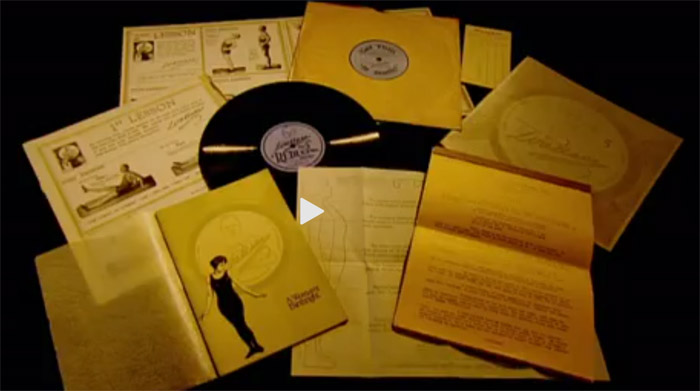
The History Detectives'
summary by host Tukufu Zuberi is that "in the mid-1930s
Wallace extended his weight-reducing method to a Chicago radio program
known by the "Get Thin to Music" slogan. After Wallace’s death in
1943, his records stayed in circulation at least until the 1950s,
but were not nearly as well known as Camp’s and almost lost to history."
The transcript for this History
Detectives episode can be downloaded from the PBS History
Detectives page.
OTHER RESOURCES
For an excellent article on Walter
Camp and "The Daily Dozen" see "Walter
Camp and the Daily Dozen: A Largely Forgotten Episode in the
History of American Physical Culture" by Mickey Phillips
and Jan Todd, The University of Texas at Austin, Volume 14, Number
4, Summer 2020, pp. 15-29 (Courtesy The
Starkcenter.org)
Poise and symmetry of figure,
Susanna Cocroft, Headington Publishing Co., 1906; Growth In Silence,
The Undertone Of Life, Susanna Cocroft, G. P. Putnams' Sons,
1917 and nine other titles are available to read on-line at HathiTrust
-- all written before Cocroft published her "weight management
with music" advertisement in 1922.

|


